HISTORIC ARTICLE
Aug 3, 1492 ce: columbus sets sail.
On August 3, 1492, Italian explorer Christopher Columbus started his voyage across the Atlantic Ocean.
Geography, Human Geography, Social Studies, U.S. History, World History

Loading ...
On August 3, 1492, Italian explorer Christopher Columbus started his voyage across the Atlantic Ocean. With a crew of 90 men and three ships—the Niña, Pinta, and Santa Maria—he left from Palos de la Frontera, Spain. Columbus reasoned that since the world is round, he could sail west to reach “the east” (the lucrative lands of India and China). That reasoning was actually sound, but the Earth is much larger than Columbus thought—large enough for him to run into two enormous continents (the “New World” of the Americas) mostly unknown to Europeans. Columbus made it to what is now the Bahamas in 61 days. He initially thought his plan was successful and the ships had reached India. In fact, he called the indigenous people “Indians,” an inaccurate name that unfortunately stuck.
Media Credits
The audio, illustrations, photos, and videos are credited beneath the media asset, except for promotional images, which generally link to another page that contains the media credit. The Rights Holder for media is the person or group credited.
Last Updated
October 19, 2023
User Permissions
For information on user permissions, please read our Terms of Service. If you have questions about how to cite anything on our website in your project or classroom presentation, please contact your teacher. They will best know the preferred format. When you reach out to them, you will need the page title, URL, and the date you accessed the resource.
If a media asset is downloadable, a download button appears in the corner of the media viewer. If no button appears, you cannot download or save the media.
Text on this page is printable and can be used according to our Terms of Service .
Interactives
Any interactives on this page can only be played while you are visiting our website. You cannot download interactives.
Related Resources
Christopher Columbus
Italian explorer Christopher Columbus discovered the “New World” of the Americas on an expedition sponsored by King Ferdinand of Spain in 1492.
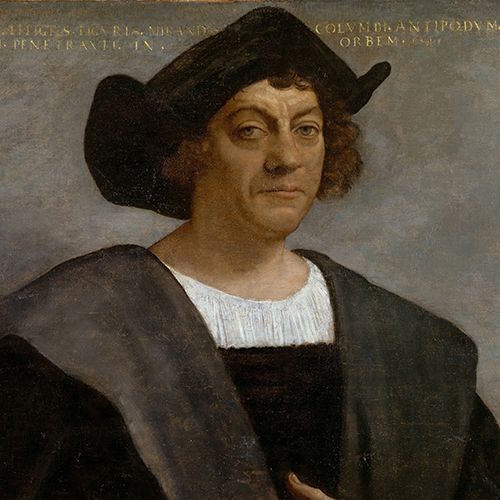
c. 1451-1506
Quick Facts
Where was columbus born, first voyages, columbus’ 1492 route and ships, where did columbus land in 1492, later voyages across the atlantic, how did columbus die, santa maria discovery claim, columbian exchange: a complex legacy, columbus day: an evolving holiday, who was christopher columbus.
Christopher Columbus was an Italian explorer and navigator. In 1492, he sailed across the Atlantic Ocean from Spain in the Santa Maria , with the Pinta and the Niña ships alongside, hoping to find a new route to Asia. Instead, he and his crew landed on an island in present-day Bahamas—claiming it for Spain and mistakenly “discovering” the Americas. Between 1493 and 1504, he made three more voyages to the Caribbean and South America, believing until his death that he had found a shorter route to Asia. Columbus has been credited—and blamed—for opening up the Americas to European colonization.
FULL NAME: Cristoforo Colombo BORN: c. 1451 DIED: May 20, 1506 BIRTHPLACE: Genoa, Italy SPOUSE: Filipa Perestrelo (c. 1479-1484) CHILDREN: Diego and Fernando
Christopher Columbus, whose real name was Cristoforo Colombo, was born in 1451 in the Republic of Genoa, part of what is now Italy. He is believed to have been the son of Dominico Colombo and Susanna Fontanarossa and had four siblings: brothers Bartholomew, Giovanni, and Giacomo, and a sister named Bianchinetta. He was an apprentice in his father’s wool weaving business and studied sailing and mapmaking.
In his 20s, Columbus moved to Lisbon, Portugal, and later resettled in Spain, which remained his home base for the duration of his life.
Columbus first went to sea as a teenager, participating in several trading voyages in the Mediterranean and Aegean seas. One such voyage, to the island of Khios, in modern-day Greece, brought him the closest he would ever come to Asia.
His first voyage into the Atlantic Ocean in 1476 nearly cost him his life, as the commercial fleet he was sailing with was attacked by French privateers off the coast of Portugal. His ship was burned, and Columbus had to swim to the Portuguese shore.
He made his way to Lisbon, where he eventually settled and married Filipa Perestrelo. The couple had one son, Diego, around 1480. His wife died when Diego was a young boy, and Columbus moved to Spain. He had a second son, Fernando, who was born out of wedlock in 1488 with Beatriz Enriquez de Arana.
After participating in several other expeditions to Africa, Columbus learned about the Atlantic currents that flow east and west from the Canary Islands.
The Asian islands near China and India were fabled for their spices and gold, making them an attractive destination for Europeans—but Muslim domination of the trade routes through the Middle East made travel eastward difficult.
Columbus devised a route to sail west across the Atlantic to reach Asia, believing it would be quicker and safer. He estimated the earth to be a sphere and the distance between the Canary Islands and Japan to be about 2,300 miles.
Many of Columbus’ contemporary nautical experts disagreed. They adhered to the (now known to be accurate) second-century BCE estimate of the Earth’s circumference at 25,000 miles, which made the actual distance between the Canary Islands and Japan about 12,200 statute miles. Despite their disagreement with Columbus on matters of distance, they concurred that a westward voyage from Europe would be an uninterrupted water route.
Columbus proposed a three-ship voyage of discovery across the Atlantic first to the Portuguese king, then to Genoa, and finally to Venice. He was rejected each time. In 1486, he went to the Spanish monarchy of Queen Isabella of Castile and Ferdinand II of Aragon. Their focus was on a war with the Muslims, and their nautical experts were skeptical, so they initially rejected Columbus.
The idea, however, must have intrigued the monarchs, because they kept Columbus on a retainer. Columbus continued to lobby the royal court, and soon, the Spanish army captured the last Muslim stronghold in Granada in January 1492. Shortly thereafter, the monarchs agreed to finance his expedition.
In late August 1492, Columbus left Spain from the port of Palos de la Frontera. He was sailing with three ships: Columbus in the larger Santa Maria (a type of ship known as a carrack), with the Pinta and the Niña (both Portuguese-style caravels) alongside.

On October 12, 1492, after 36 days of sailing westward across the Atlantic, Columbus and several crewmen set foot on an island in present-day Bahamas, claiming it for Spain.
There, his crew encountered a timid but friendly group of natives who were open to trade with the sailors. They exchanged glass beads, cotton balls, parrots, and spears. The Europeans also noticed bits of gold the natives wore for adornment.
Columbus and his men continued their journey, visiting the islands of Cuba (which he thought was mainland China) and Hispaniola (now Haiti and the Dominican Republic, which Columbus thought might be Japan) and meeting with the leaders of the native population.
During this time, the Santa Maria was wrecked on a reef off the coast of Hispaniola. With the help of some islanders, Columbus’ men salvaged what they could and built the settlement Villa de la Navidad (“Christmas Town”) with lumber from the ship.
Thirty-nine men stayed behind to occupy the settlement. Convinced his exploration had reached Asia, he set sail for home with the two remaining ships. Returning to Spain in 1493, Columbus gave a glowing but somewhat exaggerated report and was warmly received by the royal court.
In 1493, Columbus took to the seas on his second expedition and explored more islands in the Caribbean Ocean. Upon arrival at Hispaniola, Columbus and his crew discovered the Navidad settlement had been destroyed with all the sailors massacred.
Spurning the wishes of the local queen, Columbus established a forced labor policy upon the native population to rebuild the settlement and explore for gold, believing it would be profitable. His efforts produced small amounts of gold and great hatred among the native population.
Before returning to Spain, Columbus left his brothers Bartholomew and Giacomo to govern the settlement on Hispaniola and sailed briefly around the larger Caribbean islands, further convincing himself he had discovered the outer islands of China.
It wasn’t until his third voyage that Columbus actually reached the South American mainland, exploring the Orinoco River in present-day Venezuela. By this time, conditions at the Hispaniola settlement had deteriorated to the point of near-mutiny, with settlers claiming they had been misled by Columbus’ claims of riches and complaining about the poor management of his brothers.
The Spanish Crown sent a royal official who arrested Columbus and stripped him of his authority. He returned to Spain in chains to face the royal court. The charges were later dropped, but Columbus lost his titles as governor of the Indies and, for a time, much of the riches made during his voyages.
After convincing King Ferdinand that one more voyage would bring the abundant riches promised, Columbus went on his fourth and final voyage across the Atlantic Ocean in 1502. This time he traveled along the eastern coast of Central America in an unsuccessful search for a route to the Indian Ocean.
A storm wrecked one of his ships, stranding the captain and his sailors on the island of Cuba. During this time, local islanders, tired of the Spaniards’ poor treatment and obsession with gold, refused to give them food.
In a spark of inspiration, Columbus consulted an almanac and devised a plan to “punish” the islanders by taking away the moon. On February 29, 1504, a lunar eclipse alarmed the natives enough to re-establish trade with the Spaniards. A rescue party finally arrived, sent by the royal governor of Hispaniola in July, and Columbus and his men were taken back to Spain in November 1504.
In the two remaining years of his life, Columbus struggled to recover his reputation. Although he did regain some of his riches in May 1505, his titles were never returned.
Columbus probably died of severe arthritis following an infection on May 20, 1506, in Valladolid, Spain. At the time of his death, he still believed he had discovered a shorter route to Asia.
There are questions about the location of his burial site. According to the BBC , Columbus’ remains moved at least three or four times over the course of 400 years—including from Valladolid to Seville, Spain, in 1509; then to Santo Domingo, in what is now the Dominican Republic, in 1537; then to Havana, Cuba, in 1795; and back to Seville in 1898. As a result, Seville and Santo Domingo have both laid claim to being Columbus’ true burial site. It is also possible his bones were mixed up with another person’s amid all of their travels.
In May 2014, Columbus made headlines as news broke that a team of archaeologists might have found the Santa Maria off the north coast of Haiti. Barry Clifford, the leader of this expedition, told the Independent newspaper that “all geographical, underwater topography and archaeological evidence strongly suggests this wreck is Columbus’ famous flagship the Santa Maria.”
After a thorough investigation by the U.N. agency UNESCO, it was determined the wreck dates from a later period and was located too far from shore to be the famed ship.
Columbus has been credited for opening up the Americas to European colonization—as well as blamed for the destruction of the native peoples of the islands he explored. Ultimately, he failed to find that what he set out for: a new route to Asia and the riches it promised.
In what is known as the Columbian Exchange, Columbus’ expeditions set in motion the widespread transfer of people, plants, animals, diseases, and cultures that greatly affected nearly every society on the planet.
The horse from Europe allowed Native American tribes in the Great Plains of North America to shift from a nomadic to a hunting lifestyle. Wheat from the Old World fast became a main food source for people in the Americas. Coffee from Africa and sugar cane from Asia became major cash crops for Latin American countries. And foods from the Americas, such as potatoes, tomatoes and corn, became staples for Europeans and helped increase their populations.
The Columbian Exchange also brought new diseases to both hemispheres, though the effects were greatest in the Americas. Smallpox from the Old World killed millions, decimating the Native American populations to mere fractions of their original numbers. This more than any other factor allowed for European domination of the Americas.
The overwhelming benefits of the Columbian Exchange went to the Europeans initially and eventually to the rest of the world. The Americas were forever altered, and the once vibrant cultures of the Indigenous civilizations were changed and lost, denying the world any complete understanding of their existence.
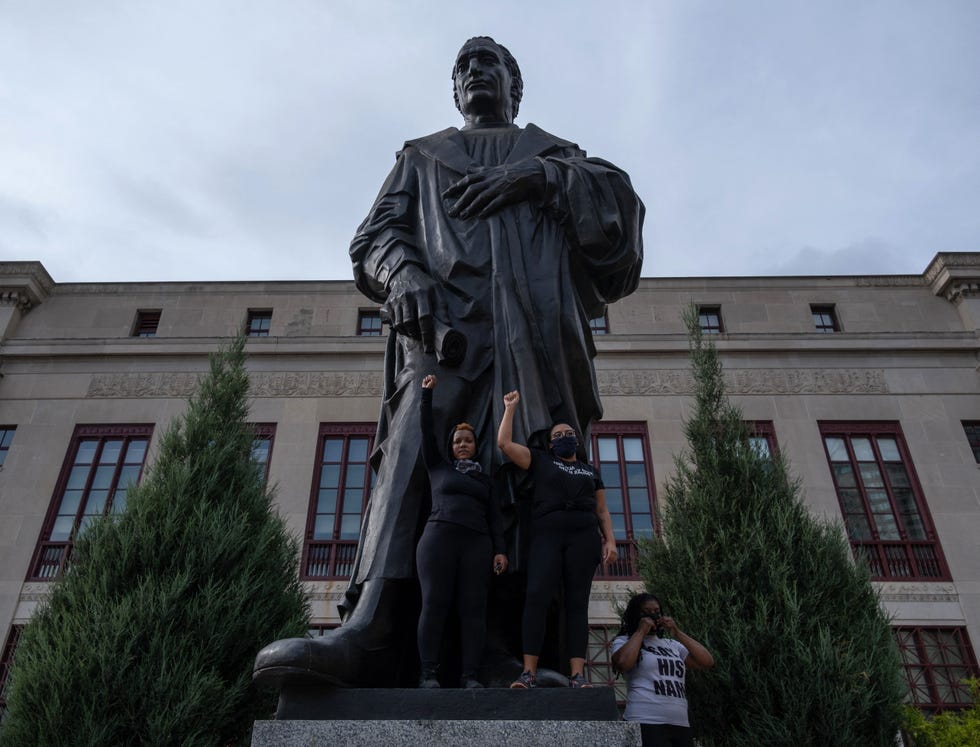
As more Italians began to immigrate to the United States and settle in major cities during the 19 th century, they were subject to religious and ethnic discrimination. This included a mass lynching of 11 Sicilian immigrants in 1891 in New Orleans.
Just one year after this horrific event, President Benjamin Harrison called for the first national observance of Columbus Day on October 12, 1892, to mark the 400 th anniversary of his arrival in the Americas. Italian-Americans saw this honorary act for Columbus as a way of gaining acceptance.
Colorado became the first state to officially observe Columbus Day in 1906 and, within five years, 14 other states followed. Thanks to a joint resolution of Congress, the day officially became a federal holiday in 1934 during the administration of Franklin D. Roosevelt . In 1970, Congress declared the holiday would fall on the second Monday in October each year.
But as Columbus’ legacy—specifically, his exploration’s impacts on Indigenous civilizations—began to draw more criticism, more people chose not to take part. As of 2023, approximately 29 states no longer celebrate Columbus Day , and around 195 cities have renamed it or replaced with the alternative Indigenous Peoples Day. The latter isn’t an official holiday, but the federal government recognized its observance in 2022 and 2023. President Joe Biden called it “a day in honor of our diverse history and the Indigenous peoples who contribute to shaping this nation.”
One of the most notable cities to move away from celebrating Columbus Day in recent years is the state capital of Columbus, Ohio, which is named after the explorer. In 2018, Mayor Andrew Ginther announced the city would remain open on Columbus Day and instead celebrate a holiday on Veterans Day. In July 2020, the city also removed a 20-plus-foot metal statue of Columbus from the front of City Hall.
- I went to sea from the most tender age and have continued in a sea life to this day. Whoever gives himself up to this art wants to know the secrets of Nature here below. It is more than forty years that I have been thus engaged. Wherever any one has sailed, there I have sailed.
- Speaking of myself, little profit had I won from twenty years of service, during which I have served with so great labors and perils, for today I have no roof over my head in Castile; if I wish to sleep or eat, I have no place to which to go, save an inn or tavern, and most often, I lack the wherewithal to pay the score.
- They say that there is in that land an infinite amount of gold; and that the people wear corals on their heads and very large bracelets of coral on their feet and arms; and that with coral they adorn and inlay chairs and chests and tables.
- This island and all the others are very fertile to a limitless degree, and this island is extremely so. In it there are many harbors on the coast of the sea, beyond comparison with others that I know in Christendom, and many rivers, good and large, which is marvelous.
- Our Almighty God has shown me the highest favor, which, since David, he has not shown to anybody.
- Already the road is opened to gold and pearls, and it may surely be hoped that precious stones, spices, and a thousand other things, will also be found.
- I have now seen so much irregularity, that I have come to another conclusion respecting the earth, namely, that it is not round as they describe, but of the form of a pear.
- In all the countries visited by your Highnesses’ ships, I have caused a high cross to be fixed upon every headland and have proclaimed, to every nation that I have discovered, the lofty estate of your Highnesses and of your court in Spain.
- I ought to be judged as a captain sent from Spain to the Indies, to conquer a nation numerous and warlike, with customs and religions altogether different to ours.
Fact Check: We strive for accuracy and fairness. If you see something that doesn’t look right, contact us !
The Biography.com staff is a team of people-obsessed and news-hungry editors with decades of collective experience. We have worked as daily newspaper reporters, major national magazine editors, and as editors-in-chief of regional media publications. Among our ranks are book authors and award-winning journalists. Our staff also works with freelance writers, researchers, and other contributors to produce the smart, compelling profiles and articles you see on our site. To meet the team, visit our About Us page: https://www.biography.com/about/a43602329/about-us
Tyler Piccotti first joined the Biography.com staff as an Associate News Editor in February 2023, and before that worked almost eight years as a newspaper reporter and copy editor. He is a graduate of Syracuse University. When he's not writing and researching his next story, you can find him at the nearest amusement park, catching the latest movie, or cheering on his favorite sports teams.
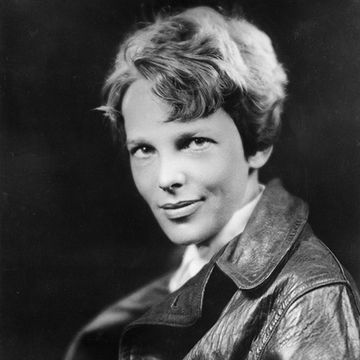
Possible Evidence of Amelia Earhart’s Plane
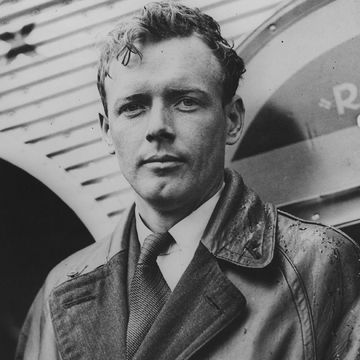
Charles Lindbergh

Was Christopher Columbus a Hero or Villain?
History & Culture
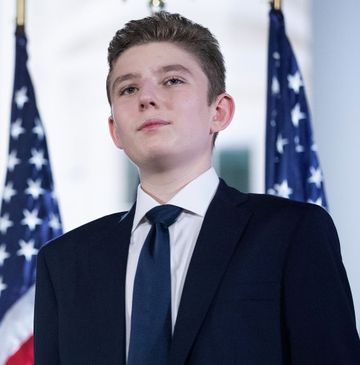
Barron Trump

Alexander McQueen
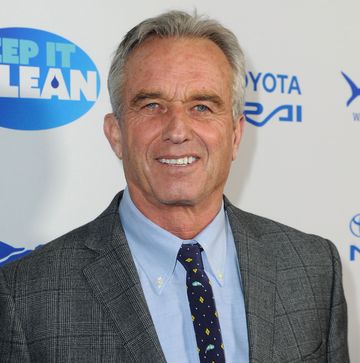
Robert F. Kennedy Jr.

Eleanor Roosevelt

Michelle Obama
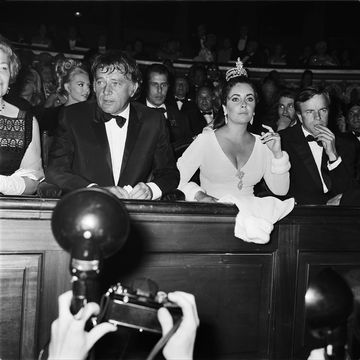
Rare Vintage Photos of Celebrities at the Opera
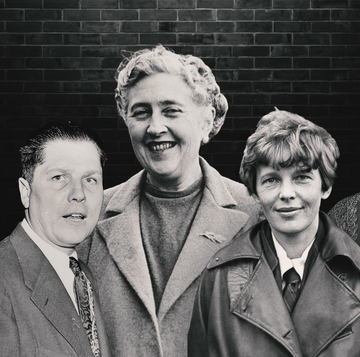
The 12 Greatest Unsolved Disappearances
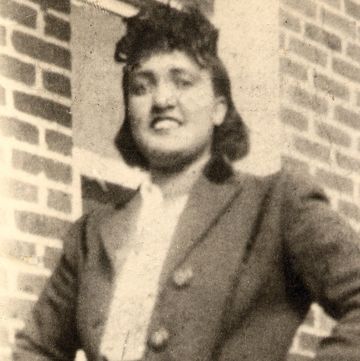
Henrietta Lacks

The Ages of Exploration
Christopher columbus, age of discovery.
Quick Facts:
He is credited for discovering the Americas in 1492, although we know today people were there long before him; his real achievement was that he opened the door for more exploration to a New World.
Name : Christopher Columbus [Kri-stə-fər] [Kə-luhm-bəs]
Birth/Death : 1451 - 1506
Nationality : Italian
Birthplace : Genoa, Italy
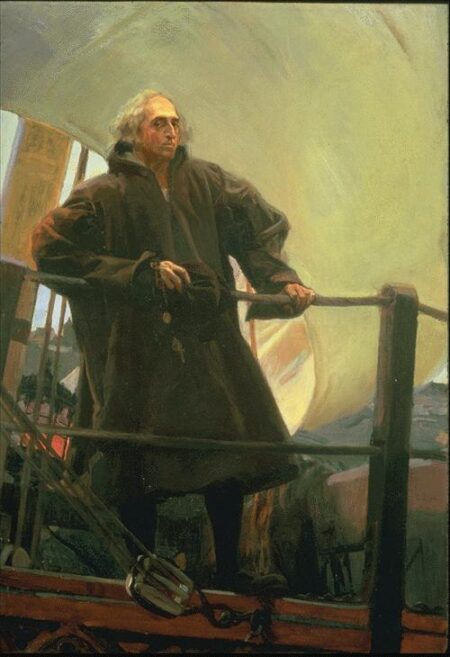
Christopher Columbus leaving Palos, Spain
Christopher Columbus aboard the "Santa Maria" leaving Palos, Spain on his first voyage across the Atlantic Ocean. The Mariners' Museum 1933.0746.000001
Introduction We know that In 1492, Columbus sailed the ocean blue. But what did he actually discover? Christopher Columbus (also known as (Cristoforo Colombo [Italian]; Cristóbal Colón [Spanish]) was an Italian explorer credited with the “discovery” of the America’s. The purpose for his voyages was to find a passage to Asia by sailing west. Never actually accomplishing this mission, his explorations mostly included the Caribbean and parts of Central and South America, all of which were already inhabited by Native groups.
Biography Early Life Christopher Columbus was born in Genoa, part of present-day Italy, in 1451. His parents’ names were Dominico Colombo and Susanna Fontanarossa. He had three brothers: Bartholomew, Giovanni, and Giacomo; and a sister named Bianchinetta. Christopher became an apprentice in his father’s wool weaving business, but he also studied mapmaking and sailing as well. He eventually left his father’s business to join the Genoese fleet and sail on the Mediterranean Sea. 1 After one of his ships wrecked off the coast of Portugal, he decided to remain there with his younger brother Bartholomew where he worked as a cartographer (mapmaker) and bookseller. Here, he married Doña Felipa Perestrello e Moniz and had two sons Diego and Fernando.
Christopher Columbus owned a copy of Marco Polo’s famous book, and it gave him a love for exploration. In the mid 15th century, Portugal was desperately trying to find a faster trade route to Asia. Exotic goods such as spices, ivory, silk, and gems were popular items of trade. However, Europeans often had to travel through the Middle East to reach Asia. At this time, Muslim nations imposed high taxes on European travels crossing through. 2 This made it both difficult and expensive to reach Asia. There were rumors from other sailors that Asia could be reached by sailing west. Hearing this, Christopher Columbus decided to try and make this revolutionary journey himself. First, he needed ships and supplies, which required money that he did not have. He went to King John of Portugal who turned him down. He then went to the rulers of England, and France. Each declined his request for funding. After seven years of trying, he was finally sponsored by King Ferdinand and Queen Isabella of Spain.
Voyages Principal Voyage Columbus’ voyage departed in August of 1492 with 87 men sailing on three ships: the Niña, the Pinta, and the Santa María. Columbus commanded the Santa María, while the Niña was led by Vicente Yanez Pinzon and the Pinta by Martin Pinzon. 3 This was the first of his four trips. He headed west from Spain across the Atlantic Ocean. On October 12 land was sighted. He gave the first island he landed on the name San Salvador, although the native population called it Guanahani. 4 Columbus believed that he was in Asia, but was actually in the Caribbean. He even proposed that the island of Cuba was a part of China. Since he thought he was in the Indies, he called the native people “Indians.” In several letters he wrote back to Spain, he described the landscape and his encounters with the natives. He continued sailing throughout the Caribbean and named many islands he encountered after his ship, king, and queen: La Isla de Santa María de Concepción, Fernandina, and Isabella.
It is hard to determine specifically which islands Columbus visited on this voyage. His descriptions of the native peoples, geography, and plant life do give us some clues though. One place we do know he stopped was in present-day Haiti. He named the island Hispaniola. Hispaniola today includes both Haiti and the Dominican Republic. In January of 1493, Columbus sailed back to Europe to report what he found. Due to rough seas, he was forced to land in Portugal, an unfortunate event for Columbus. With relations between Spain and Portugal strained during this time, Ferdinand and Isabella suspected that Columbus was taking valuable information or maybe goods to Portugal, the country he had lived in for several years. Those who stood against Columbus would later use this as an argument against him. Eventually, Columbus was allowed to return to Spain bringing with him tobacco, turkey, and some new spices. He also brought with him several natives of the islands, of whom Queen Isabella grew very fond.
Subsequent Voyages Columbus took three other similar trips to this region. His second voyage in 1493 carried a large fleet with the intention of conquering the native populations and establishing colonies. At one point, the natives attacked and killed the settlers left at Fort Navidad. Over time the colonists enslaved many of the natives, sending some to Europe and using many to mine gold for the Spanish settlers in the Caribbean. The third trip was to explore more of the islands and mainland South America further. Columbus was appointed the governor of Hispaniola, but the colonists, upset with Columbus’ leadership appealed to the rulers of Spain, who sent a new governor: Francisco de Bobadilla. Columbus was taken prisoner on board a ship and sent back to Spain.
On his fourth and final journey west in 1502 Columbus’s goal was to find the “Strait of Malacca,” to try to find India. But a hurricane, then being denied entrance to Hispaniola, and then another storm made this an unfortunate trip. His ship was so badly damaged that he and his crew were stranded on Jamaica for two years until help from Hispaniola finally arrived. In 1504, Columbus and his men were taken back to Spain .
Later Years and Death Columbus reached Spain in November 1504. He was not in good health. He spent much of the last of his life writing letters to obtain the percentage of wealth overdue to be paid to him, and trying to re-attain his governorship status, but was continually denied both. Columbus died at Valladolid on May 20, 1506, due to illness and old age. Even until death, he still firmly believing that he had traveled to the eastern part of Asia.
Legacy Columbus never made it to Asia, nor did he truly discover America. His “re-discovery,” however, inspired a new era of exploration of the American continents by Europeans. Perhaps his greatest contribution was that his voyages opened an exchange of goods between Europe and the Americas both during and long after his journeys. 5 Despite modern criticism of his treatment of the native peoples there is no denying that his expeditions changed both Europe and America. Columbus day was made a federal holiday in 1971. It is recognized on the second Monday of October.
- Fergus Fleming, Off the Map: Tales of Endurance and Exploration (New York: Grove Press, 2004), 30.
- Fleming, Off the Map, 30
- William D. Phillips and Carla Rahn Phillips, The Worlds of Christopher Columbus (New York: Cambridge University Press, 1993), 142-143.
- Phillips and Phillips, The Worlds of Christopher Columbus, 155.
- Robin S. Doak, Christopher Columbus: Explorer of the New World (Minneapolis: Compass Point Books, 2005), 92.
Bibliography
Doak, Robin. Christopher Columbus: Explorer of the New World. Minneapolis: Compass Point Books, 2005.
Fleming, Fergus. Off the Map: Tales of Endurance and Exploration. New York: Grove Press, 2004.
Phillips, William D., and Carla Rahn Phillips. The Worlds of Christopher Columbus. New York: Cambridge University Press, 1993.
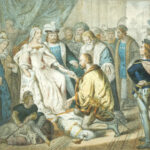
Map of Voyages
Click below to view an example of the explorer’s voyages. Use the tabs on the left to view either 1 or multiple journeys at a time, and click on the icons to learn more about the stops, sites, and activities along the way.
- Original "EXPLORATION through the AGES" site
- The Mariners' Educational Programs

- History Classics
- Your Profile
- Find History on Facebook (Opens in a new window)
- Find History on Twitter (Opens in a new window)
- Find History on YouTube (Opens in a new window)
- Find History on Instagram (Opens in a new window)
- Find History on TikTok (Opens in a new window)
- This Day In History
- History Podcasts
- History Vault
This Day In History : October 12
Changing the day will navigate the page to that given day in history. You can navigate days by using left and right arrows
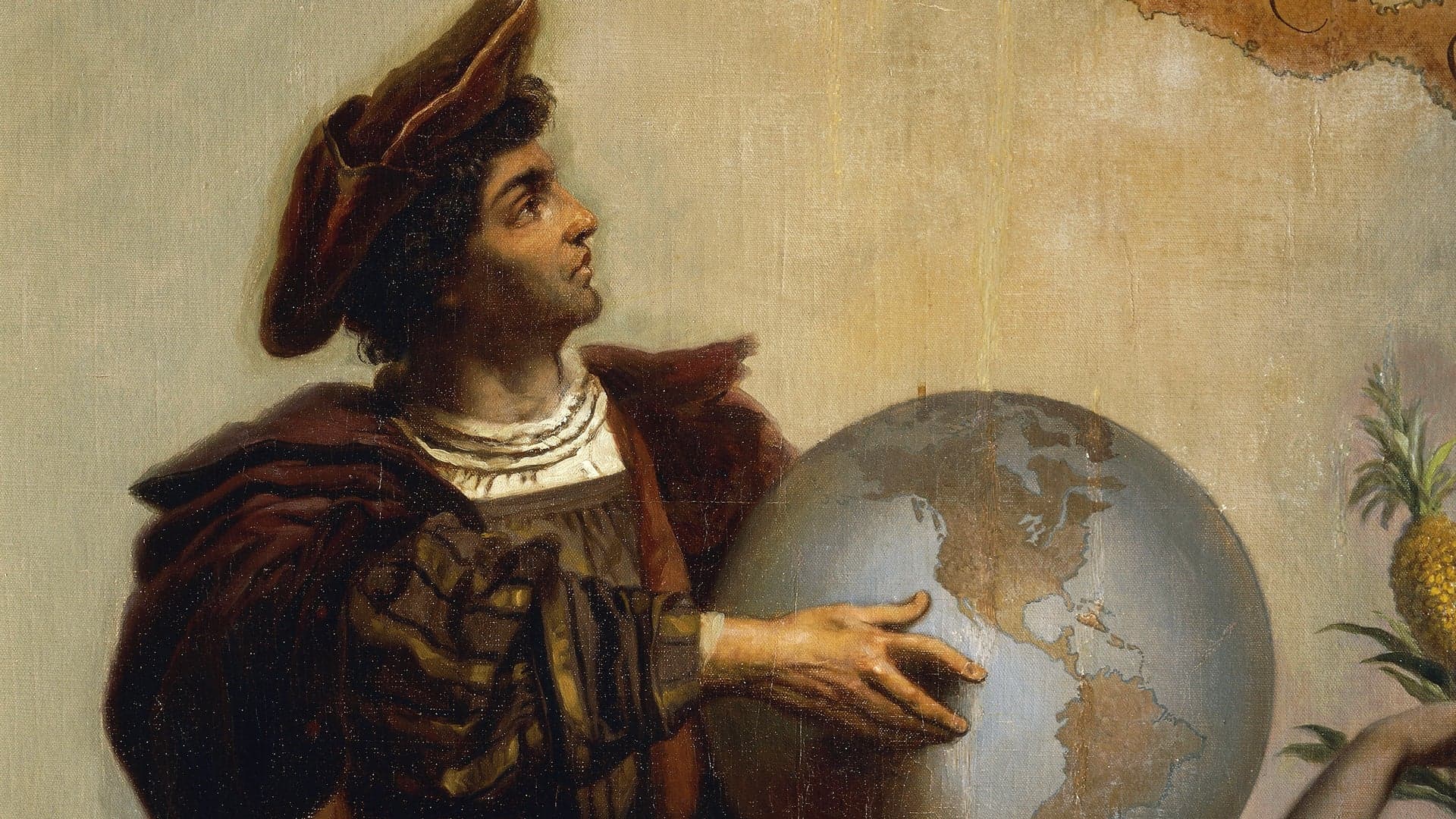
Columbus reaches the “New World”
After sailing across the Atlantic Ocean, Italian explorer Christopher Columbus sights a Bahamian island on October 12, 1492, believing he has reached East Asia. His expedition went ashore the same day and claimed the land for Isabella and Ferdinand of Spain , who sponsored his attempt to find a western ocean route to China, India, and the fabled gold and spice islands of Asia.
Columbus was born in Genoa, Italy, in 1451. Little is known of his early life, but he worked as a seaman and then a maritime entrepreneur. He became obsessed with the possibility of pioneering a western sea route to Cathay (China), India, and the gold and spice islands of Asia. At the time, Europeans knew no direct sea route to southern Asia, and the route via Egypt and the Red Sea was closed to Europeans by the Ottoman Empire , as were many land routes.
Contrary to popular legend, educated Europeans of Columbus’ day did believe that the world was round, as argued by St. Isidore in the seventh century. However, Columbus, and most others, underestimated the world’s size, calculating that East Asia must lie approximately where North America sits on the globe (they did not yet know that the Pacific Ocean existed).
With only the Atlantic Ocean, he thought, lying between Europe and the riches of the East Indies, Columbus met with King John II of Portugal and tried to persuade him to back his “Enterprise of the Indies,” as he called his plan. He was rebuffed and went to Spain, where he was also rejected at least twice by King Ferdinand and Queen Isabella. However, after the Spanish conquest of the Moorish kingdom of Granada in January 1492, the Spanish monarchs, flush with victory, agreed to support his voyage.
On August 3, 1492, Columbus set sail from Palos, Spain, with three small ships, the Santa Maria, the Pinta and the Nina . On October 12, the expedition reached land, probably Watling Island in the Bahamas. Later that month, Columbus sighted Cuba, which he thought was mainland China, and in December the expedition landed on Hispaniola, which Columbus thought might be Japan. He established a small colony there with 39 of his men. The explorer returned to Spain with gold, spices, and “Indian” captives in March 1493 and was received with the highest honors by the Spanish court. He was the first European to explore the Americas since the Vikings set up colonies in Greenland and Newfoundland in the 10th century.
During his lifetime, Columbus led a total of four expeditions to the "New World," exploring various Caribbean islands, the Gulf of Mexico, and the South and Central American mainlands, but he never accomplished his original goal—a western ocean route to the great cities of Asia. Columbus died in Spain in 1506 without realizing the scope of what he did achieve: He had discovered for Europe the New World, whose riches over the next century would help make Spain the wealthiest and most powerful nation on earth. He also unleashed centuries of brutal colonization, the transatlantic slave trade and the deaths of millions of Native Americans from murder and disease.
Columbus was honored with a U.S. federal holiday in 1937. Since 1991, many cities, universities and a growing number of states have adopted Indigenous Peoples’ Day , a holiday that celebrates the history and contributions of Native Americans. Not by coincidence, the occasion usually falls on Columbus Day , the second Monday in October, or replaces the holiday entirely. Why replace Columbus Day with Indigenous Peoples’ Day? Some argue that the holiday overlooks Columbus' enslavement of Native Americans—while giving him credit for “discovering” a place where people already lived.
Also on This Day in History October | 12
This day in history video: what happened on october 12.

Silent-film star Tom Mix dies in Arizona car wreck
Uss cole attacked by terrorists, the origin of oktoberfest, ussr leads the space race, terrorists kill 202 in bali.

Wake Up to This Day in History
Sign up now to learn about This Day in History straight from your inbox. Get all of today's events in just one email featuring a range of topics.
By submitting your information, you agree to receive emails from HISTORY and A+E Networks. You can opt out at any time. You must be 16 years or older and a resident of the United States.
More details : Privacy Notice | Terms of Use | Contact Us
Conscientious objector awarded Medal of Honor
Racial violence breaks out aboard u.s. navy ships, thomas jefferson composes romantic letter, john denver dies in an aircraft accident, al gore wins nobel prize in the wake of "an inconvenient truth", fire rages in minnesota, matthew shepard, victim of anti-gay hate crime, dies, nikita khrushchev allegedly brandishes his shoe at the united nations, robert e. lee dies.
MA in American History : Apply now and enroll in graduate courses with top historians this summer!
- AP US History Study Guide
- History U: Courses for High School Students
- History School: Summer Enrichment
- Lesson Plans
- Classroom Resources
- Spotlights on Primary Sources
- Professional Development (Academic Year)
- Professional Development (Summer)
- Book Breaks
- Inside the Vault
- Self-Paced Courses
- Browse All Resources
- Search by Issue
- Search by Essay
- Become a Member (Free)
- Monthly Offer (Free for Members)
- Program Information
- Scholarships and Financial Aid
- Applying and Enrolling
- Eligibility (In-Person)
- EduHam Online
- Hamilton Cast Read Alongs
- Official Website
- Press Coverage
- Veterans Legacy Program
- The Declaration at 250
- Black Lives in the Founding Era
- Celebrating American Historical Holidays
- Browse All Programs
- Donate Items to the Collection
- Search Our Catalog
- Research Guides
- Rights and Reproductions
- See Our Documents on Display
- Bring an Exhibition to Your Organization
- Interactive Exhibitions Online
- About the Transcription Program
- Civil War Letters
- Founding Era Newspapers
- College Fellowships in American History
- Scholarly Fellowship Program
- Richard Gilder History Prize
- David McCullough Essay Prize
- Affiliate School Scholarships
- Nominate a Teacher
- Eligibility
- State Winners
- National Winners
- Gilder Lehrman Lincoln Prize
- Gilder Lehrman Military History Prize
- George Washington Prize
- Frederick Douglass Book Prize
- Our Mission and History
- Annual Report
- Contact Information
- Student Advisory Council
- Teacher Advisory Council
- Board of Trustees
- Remembering Richard Gilder
- President's Council
- Scholarly Advisory Board
- Internships
- Our Partners
- Press Releases
History Resources

Landing of Columbus, 1492
A spotlight on a primary source by martin, johnson & co..
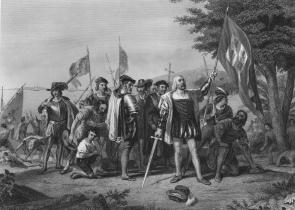
This engraving, by H. B. Hall, is based on an oil painting by John Vanderlyn. Vanderlyn (1775–1852) was an American neoclassicist painter from Kingston, New York. In 1836, Vanderlyn was commissioned by Congress to paint The Landing of Columbus . A commission of that caliber was both a boon to an artist’s standing and an opportunity to create an enduring historical image, and the painting would prove to be one of Vanderlyn’s most well-known works. He completed the painting in 1846, and it was mounted in the Rotunda of the Capitol in 1847. Vanderlyn’s portrayal soon appeared in advertisements, on postage stamps in 1869 and 1893, and on currency in the 1870s. Viewed by thousands in the Capitol and by countless more in various incarnations, The Landing of Columbus came to be the prevailing representation in the American imagination of Columbus’s discovery of the New World.
[1] Christopher Columbus, The Journal of Christopher Columbus (During His First Voyage, 1492–93) and Documents Relating to the Voyages of John Cabot and Gaspar Corte Real (London: Hakluyt Society, 1893) 37.
[2] Columbus, Journal , 112.
[3] Columbus, Journal , 48.
Questions for Discussion
Read the introduction and study the image before answering the following questions:
- Compare the expressions and physical gestures of Columbus and his men to those of the American Indians in this painting. Why do you think the artist chose this depiction?
- In recent years controversy has developed over images such as these. Why was this painting very popular in the 1800s and harshly criticized by some groups recently?

A printer-friendly version is available here .
Stay up to date, and subscribe to our quarterly newsletter..
Learn how the Institute impacts history education through our work guiding teachers, energizing students, and supporting research.
The Second Voyage of Christopher Columbus
Second Voyage Adds Colonization and Trading Posts to Exploration Goals
Preparations for the Second Voyage
Dominica, guadalupe and the antilles, hispaniola and the fate of la navidad, cuba and jamaica, columbus as governor, the start of the enslaved indigenous peoples trade, people of note in columbus’ second voyage, historical importance of the second voyage.
- Ph.D., Spanish, Ohio State University
- M.A., Spanish, University of Montana
- B.A., Spanish, Penn State University
Christopher Columbus returned from his first voyage in March 1493, having discovered the New World—although he didn’t know it. He still believed that he had found some uncharted islands near Japan or China and that further exploration was needed. His first voyage had been a bit of a fiasco, as he had lost one of the three ships entrusted to him and he did not bring back much in the way of gold or other valuable items. He did, however, bring back a group of Indigenous people he had enslaved on the island of Hispaniola, and he was able to convince the Spanish crown to finance the second voyage of discovery and colonization.
The second voyage was to be a large-scale colonization and exploration project. Columbus was given 17 ships and over 1,000 men. Included on this voyage, for the first time, were European domesticated animals such as pigs, horses, and cattle. Columbus’ orders were to expand the settlement on Hispaniola, convert the population of Indigenous people to Christianity, establish a trading post, and continue his explorations in search of China or Japan. The fleet set sail on October 13, 1493, and made excellent time, first sighting land on November 3.
The island first sighted was named Dominica by Columbus, a name it retains to this day. Columbus and some of his men visited the island, but it was inhabited by fierce Caribs and they did not stay very long. Moving on, they discovered and explored a number of small islands, including Guadalupe, Montserrat, Redondo, Antigua, and several others in the Leeward Islands and Lesser Antilles chains. He also visited Puerto Rico before making his way back to Hispaniola.
Columbus had wrecked one of his three ships the year of his first voyage. He had been forced to leave 39 of his men behind on Hispaniola, in a small settlement named La Navidad . Upon returning to the island, Columbus discovered that the men he left had raped Indigenous women and angered the population. Indigenous people had then attacked the settlement, slaughtering the Europeans to the last man. Columbus, consulting his Indigenous chieftain ally Guacanagarí, laid the blame on Caonabo, a rival chief. Columbus and his men attacked, routing Caonabo and capturing and enslaving many of the people.
Columbus founded the town of Isabella on the northern coast of Hispaniola, and spent the next five months or so getting the settlement established and exploring the island. Building a town in a steamy land with inadequate provisions is hard work, and many of the men became sick and died. It reached the point where a group of settlers, led by Bernal de Pisa, attempted to capture and make off with several ships and go back to Spain: Columbus learned of the revolt and punished the plotters. The settlement of Isabella remained but never thrived. It was abandoned in 1496 in favor of a new site, now Santo Domingo .
Columbus left the settlement of Isabella in the hands of his brother Diego in April, setting out to explore the region further. He reached Cuba (which he had discovered on his first voyage) on April 30 and explored it for several days before moving on to Jamaica on May 5. He spent the next few weeks exploring the treacherous shoals around Cuba and searching in vain for the mainland. Discouraged, he returned to Isabella on August 20, 1494.
Columbus had been appointed governor and Viceroy of the new lands by the Spanish crown, and for the next year and a half, he attempted to do his job. Unfortunately, Columbus was a good ship’s captain but a lousy administrator, and those colonists that still survived grew to hate him. The gold they had been promised never materialized and Columbus kept most of what little wealth was found for himself. Supplies began running out, and in March of 1496 Columbus returned to Spain to ask for more resources to keep the struggling colony alive.
Columbus brought back many enslaved Indigenous people with him. Columbus, who had once again promised gold and trade routes, did not want to return to Spain empty-handed. Queen Isabella , appalled, decreed that the New World Indigenous people were subjects of the Spanish crown and therefore could not be enslaved. However, the practice of enslaving Indigenous populations continued.
- Ramón Pané was a Catalan priest who lived among the Taíno people for about four years and produced a short but very important ethnographic history of their culture.
- Francisco de Las Casas was an adventurer whose son Bartolomé was destined to become very important in the fight for the rights of Indigenous people.
- Diego Velázquez was a conquistador who later became governor of Cuba.
- Juan de la Cosa was an explorer and cartographer who produced several important early maps of the Americas.
- Juan Ponce de León would become governor of Puerto Rico but was most famous for his journey to Florida in search of the Fountain of Youth .
Columbus’ second voyage marked the start of colonialism in the New World, the social importance of which cannot be overstated. By establishing a permanent foothold, Spain took the first steps toward its mighty empire of the centuries that followed, an empire that was built with New World gold and silver.
When Columbus brought back enslaved Indigenous peoples to Spain, he also caused the question of whether to practice enslavement in the New World to be aired openly, and Queen Isabella decided that her new subjects could not be enslaved. But although Isabella perhaps prevented a few instances of enslavement, the conquest and colonization of the New World was devastating and deadly for Indigenous peoples: their population dropped by approximately 80% between 1492 and the mid-17th century. The drop was caused mainly by the arrival of Old World diseases, but others died as a result of violent conflict or enslavement.
Many of those who sailed with Columbus on his second voyage went on to play very important roles in the trajectory of history in the New World. These first colonists had a significant amount of influence and power over the span of the next few decades.
- Herring, Hubert. A History of Latin America From the Beginnings to the Present . New York: Alfred A. Knopf, 1962.
- Thomas, Hugh. "Rivers of Gold: The Rise of the Spanish Empire, from Columbus to Magellan." Hardcover, 1st edition, Random House, June 1, 2004.
- The Third Voyage of Christopher Columbus
- Biography of Christopher Columbus
- 10 Facts About Christopher Columbus
- The Truth About Christopher Columbus
- Biography of Christopher Columbus, Italian Explorer
- La Navidad: First European Settlement in the Americas
- The First New World Voyage of Christopher Columbus (1492)
- Biography of Juan Ponce de León, Conquistador
- The Fourth Voyage of Christopher Columbus
- Biography of Bartolomé de Las Casas, Spanish Colonist
- Biography of Diego Velazquez de Cuellar, Conquistador
- Where Are the Remains of Christopher Columbus?
- The Florida Expeditions of Ponce de Leon
- The Controversy Over Columbus Day Celebrations
- The History of Santo Domingo, Dominican Republic

Million Dollar Sense
15 Voyages and Discoveries That Transformed the World
Posted: May 7, 2024 | Last updated: May 7, 2024

#1 Christopher Columbus’s First Voyage
In 1492, Christopher Columbus embarked on his famous first voyage. With backing from the Spanish crown, he set sail from Spain with three ships – the Niña, the Pinta, and the Santa Maria. His goal was to find a westward route to Asia, believing the world to be round. After a long journey across the Atlantic, his crew grew restless, but on October 12th, land was finally spotted. Columbus believed he had reached the Indies (Asia), but he had unknowingly landed in the Bahamas, marking the beginning of a new era of exploration and eventual European colonization of the Americas.
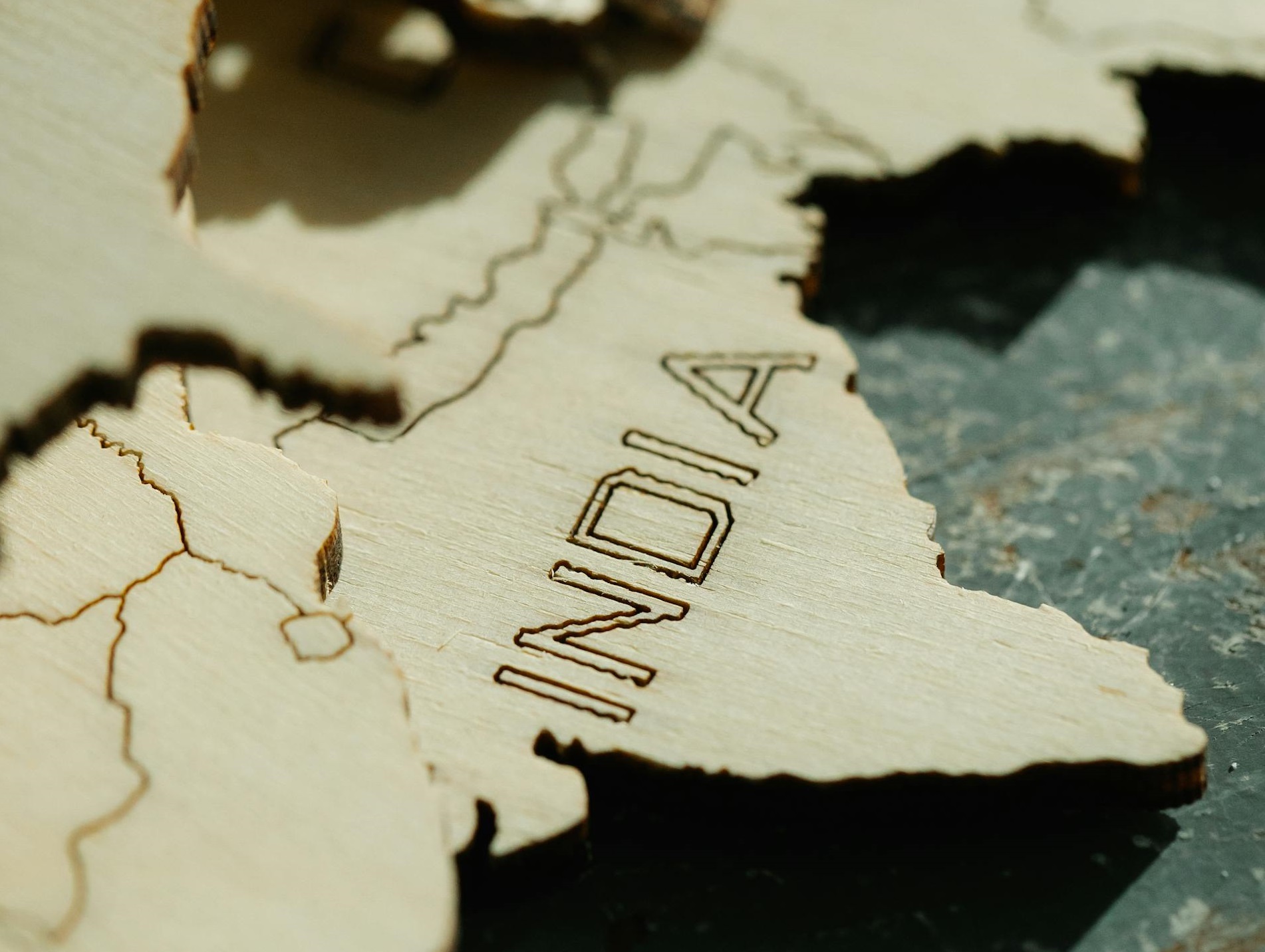
#2 Vasco da Gama’s Voyage to India
Portuguese explorer Vasco da Gama set sail in 1497, determined to find a water route to India. Leading a fleet of four ships, he rounded the tip of Africa, braving treacherous waters and sickness. After reaching the east coast of Africa, he secured a pilot with knowledge of the Indian Ocean. Finally, in 1498, da Gama reached Calicut, India, becoming the first European to sail directly from Europe to India. This voyage opened a new era of trade and exploration, forever linking Europe and Asia.
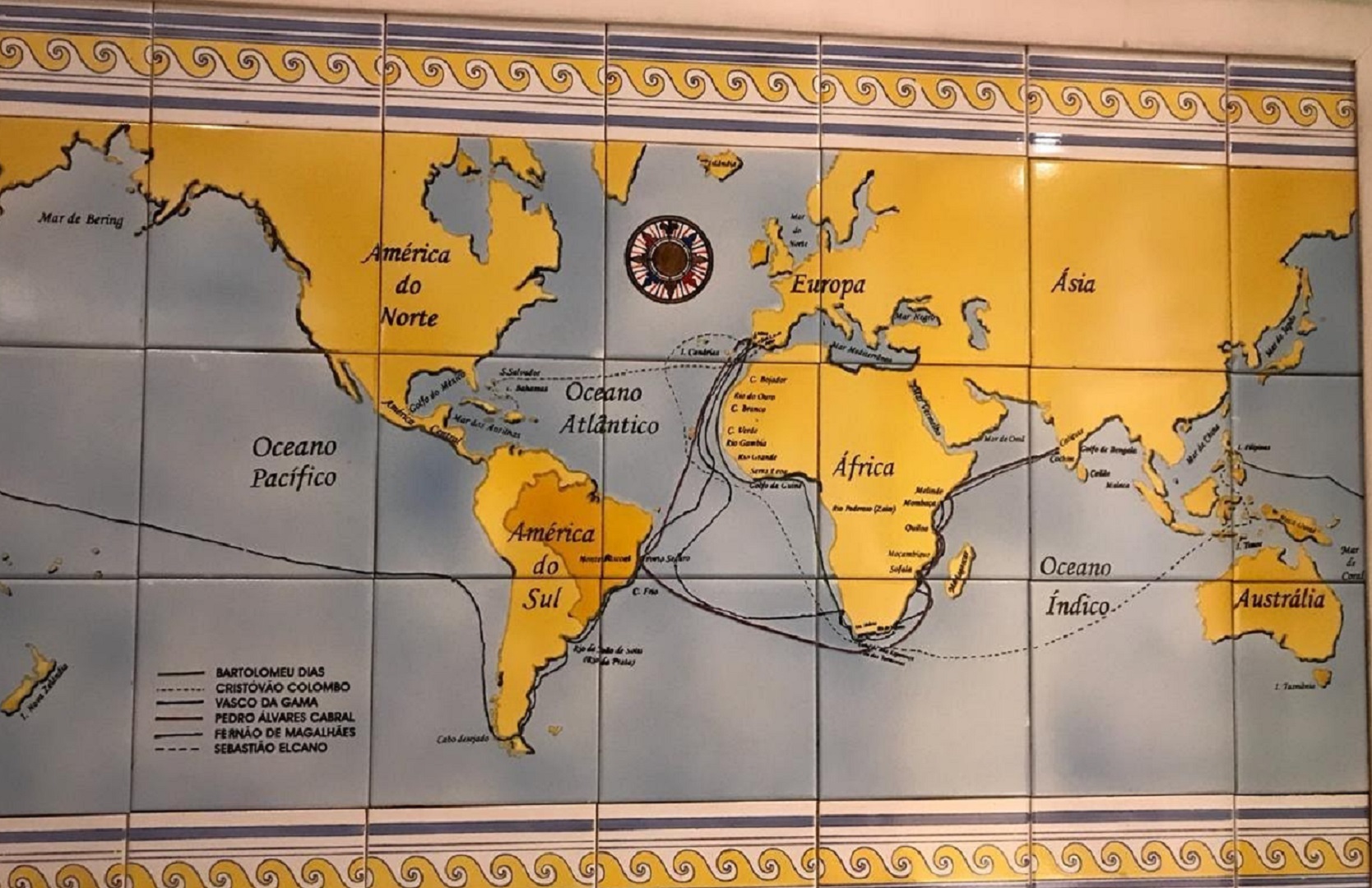
#3 Ferdinand Magellan’s Circumnavigation
Ferdinand Magellan’s ambitious expedition set sail from Spain in 1519, aiming to find a western route to the Spice Islands. Though Magellan himself died on the journey, his crew persevered through hardship and became the first to circle the globe, proving the Earth’s roundness. Their accomplishment in 1522 forever changed European understanding of geography and opened doors for future exploration and colonization.
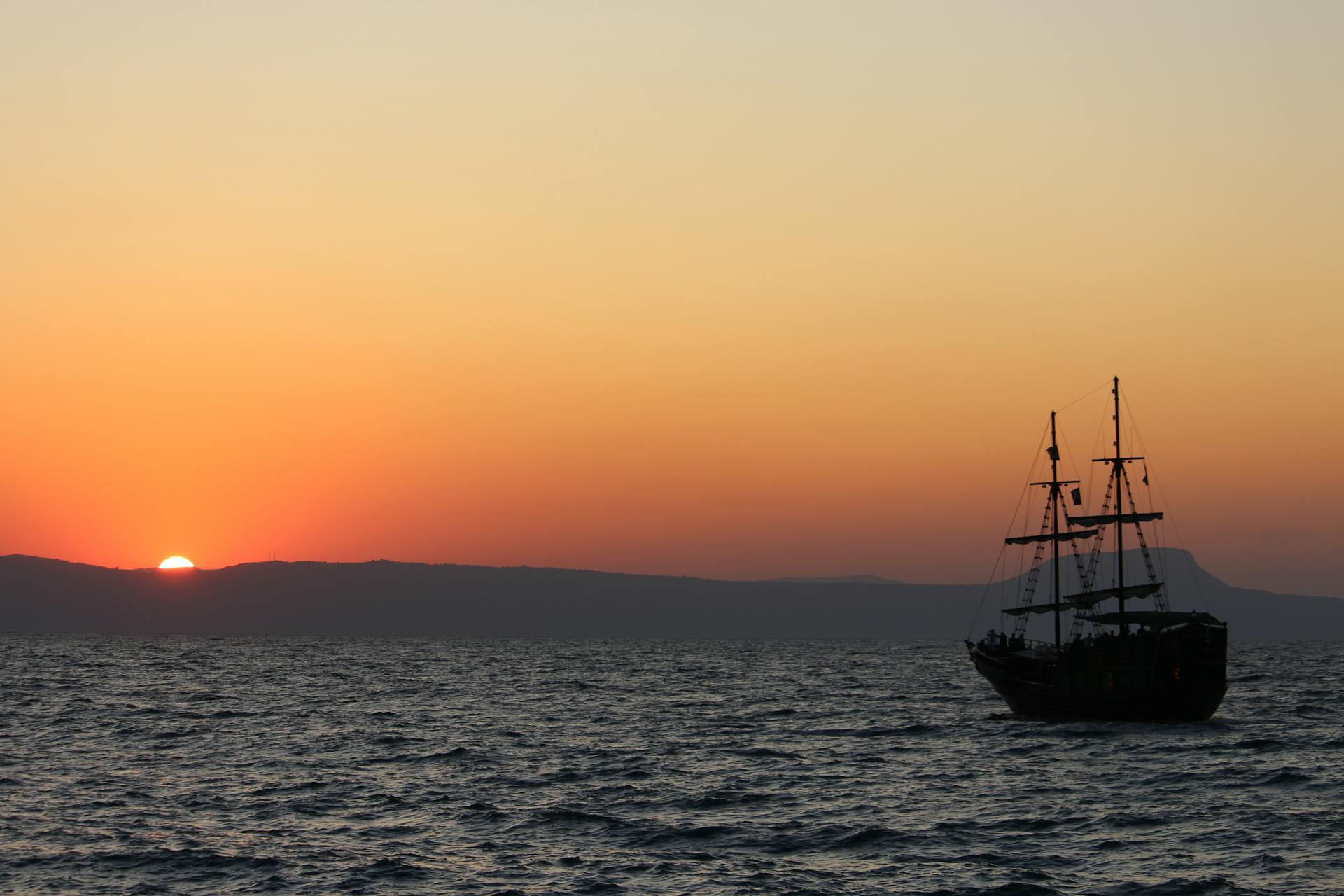
#4 Voyage of Hernán Cortés to Mexico
In 1519, Hernán Cortés defied orders and set sail for Mexico with a fleet of hundreds. Landing on the Yucatán Peninsula, he gained vital alliances with indigenous groups who harbored resentment towards the Aztec Empire. With these allies and his own weaponry, including cannons and horses, Cortés marched towards the Aztec capital, Tenochtitlan. Through a combination of strategy, manipulation, and ruthlessness, Cortés conquered the Aztec Empire in 1521, marking a turning point in Mexican history and the beginning of Spanish colonial rule in the region.
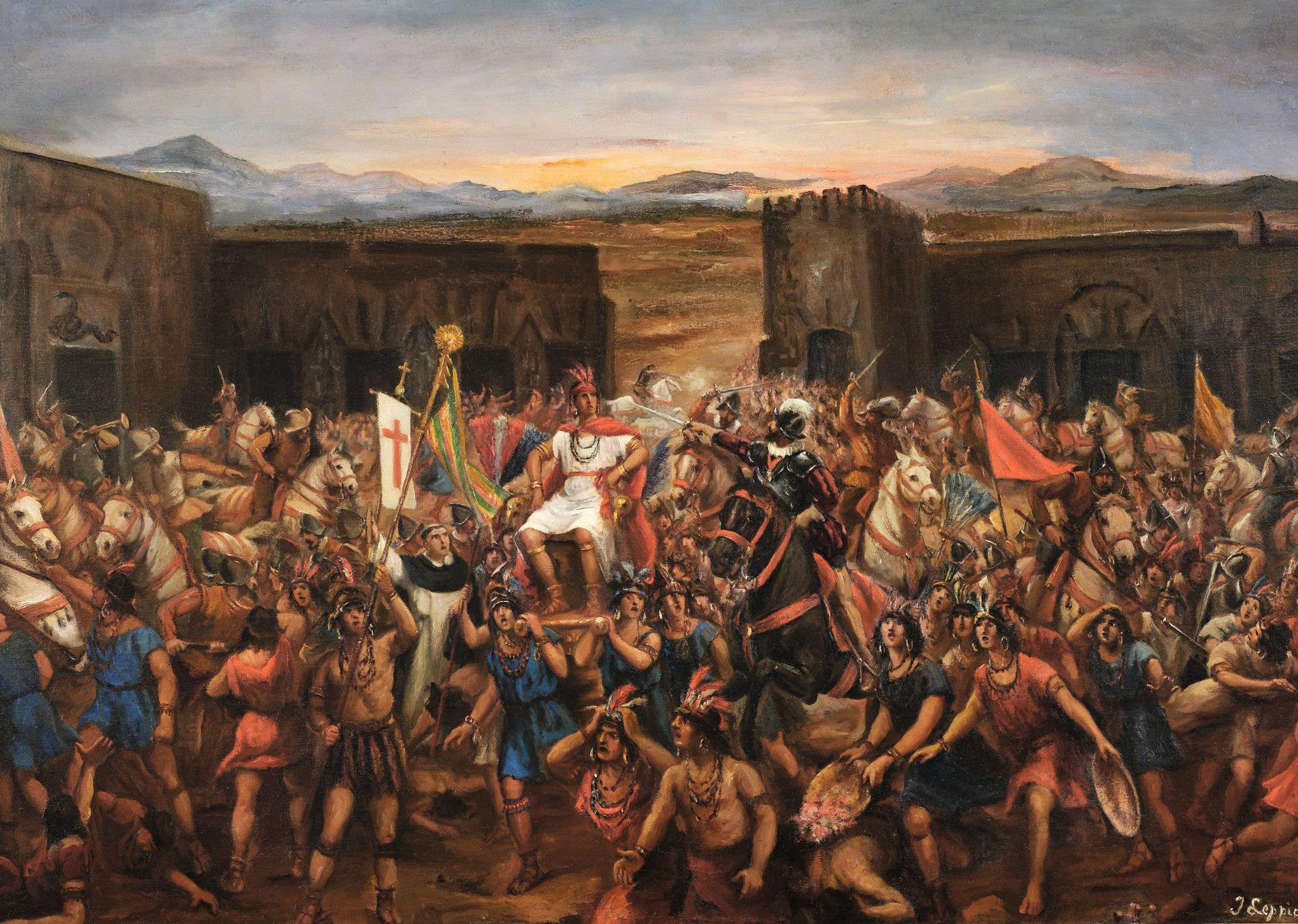
#5 Francisco Pizarro’s Conquest of the Inca Empire
Francisco Pizarro’s conquest of the Inca Empire in the 1530s was a decisive and brutal episode. With a small force of Spanish soldiers and aided by existing Inca civil war tensions, Pizarro captured the Inca emperor Atahualpa in 1532. Despite a massive ransom paid in gold, Atahualpa was executed, shattering Inca leadership. Pizarro then marched on the Inca capital, Cuzco, seizing control of the vast empire. This swift conquest, fueled by superior weaponry and tactics, marked the end of the Inca Empire and paved the way for the Spanish colonization of Peru.
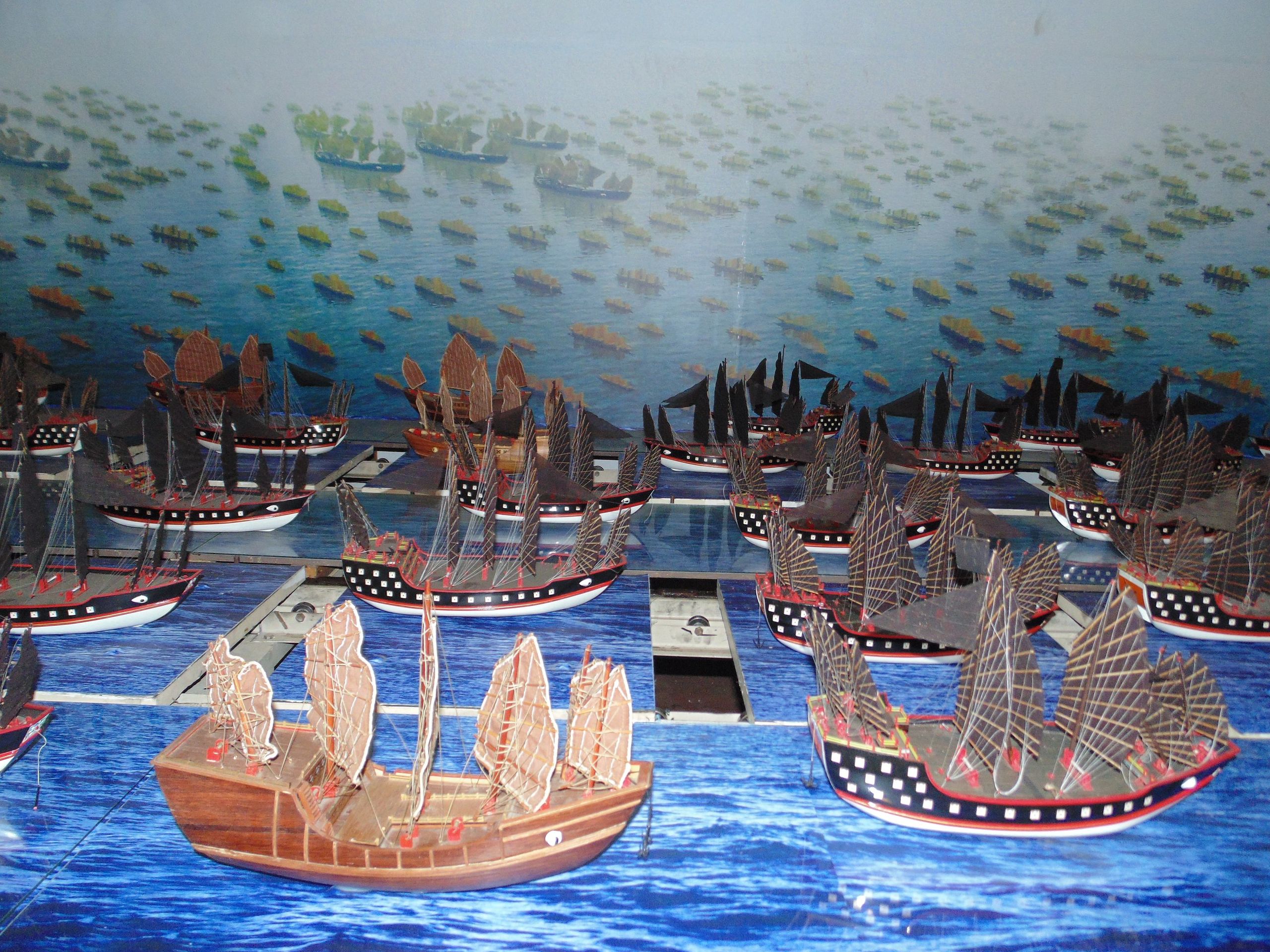
#6 Zheng He’s Treasure Voyages
Zheng He, an admiral under China’s Ming Dynasty, commanded seven epic voyages between 1405 and 1433. Leading massive fleets, Zheng He explored Southeast Asia, India, the Persian Gulf, and even reached East Africa. These expeditions aimed to display China’s power and establish trade relations. Zheng He’s peaceful approach, with gifts and diplomacy, fostered cultural exchange and secured China’s maritime influence for decades.
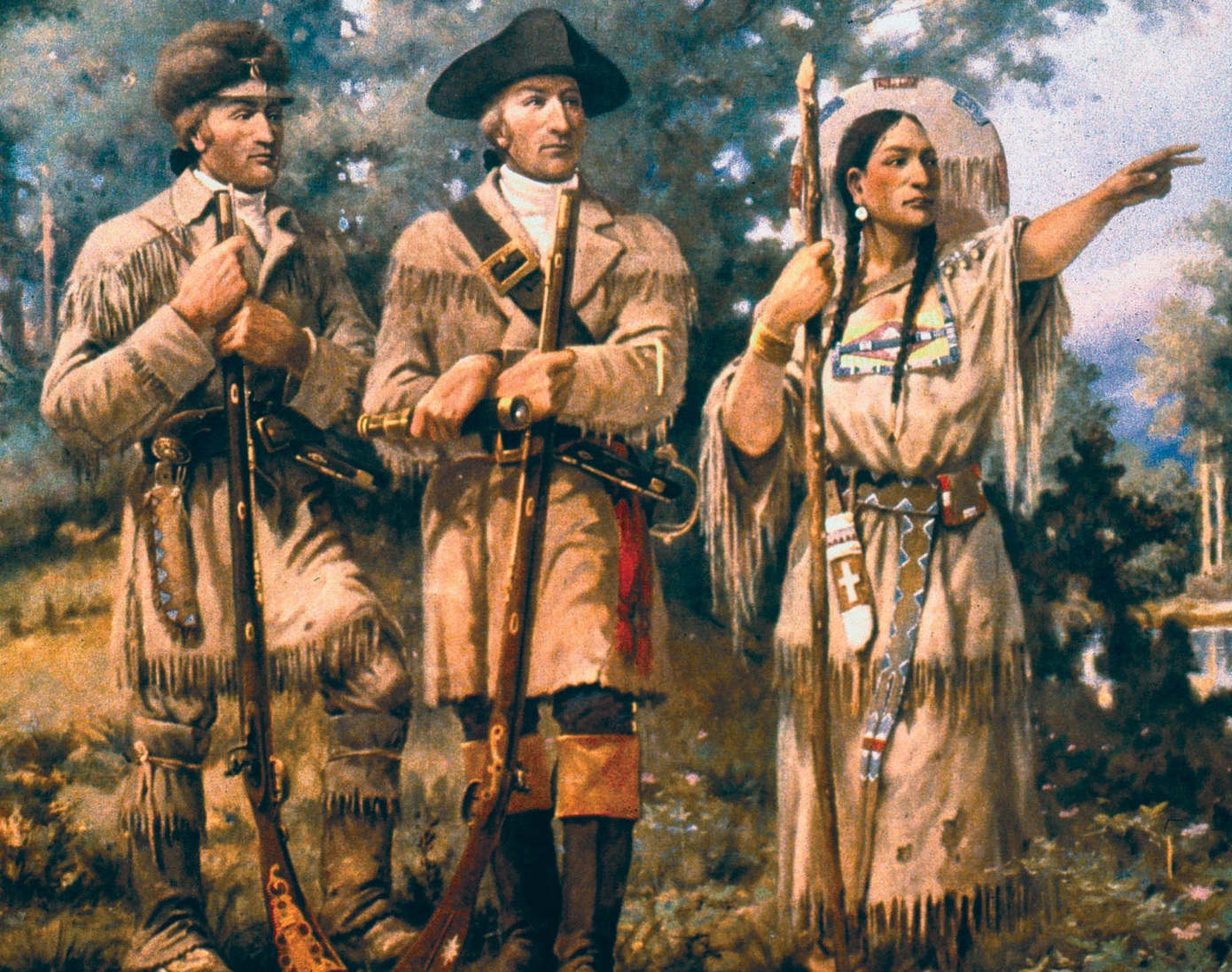
#7 Lewis and Clark Expedition
Led by Meriwether Lewis and William Clark, the team ventured deep into the unknown of America, navigating rivers, crossing mountains, and finally reaching the Pacific Coast. Their journey documented a wealth of new plants and animals, recorded interactions with Native American tribes, and mapped vast stretches of unexplored land. This valuable information provided crucial insights into the geography and resources of the American West.
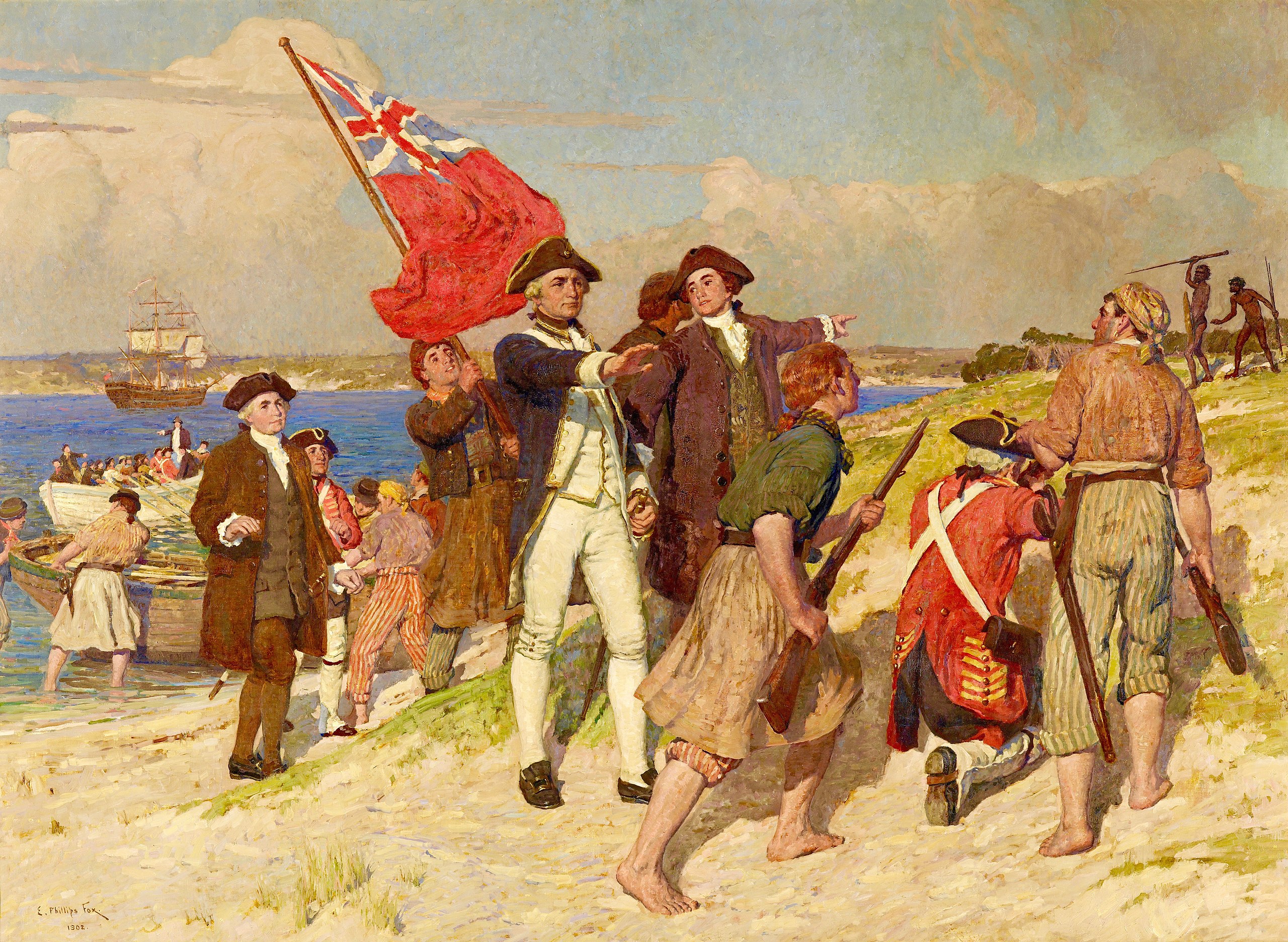
#8 James Cook’s First Voyage
Lieutenant James Cook’s first voyage, lasting from 1768 to 1771, was a landmark expedition funded by the British crown. Sailing aboard HMS Endeavour, Cook had a dual mission. Officially, he was to observe the transit of Venus across the sun from Tahiti. However, a more secretive objective was to search for the long-hypothesized continent of Terra Australis Incognita (Great Southland) in the Pacific. Cook’s exceptional navigational skills and meticulous charting led him to map previously unknown coastlines, including New Zealand, which Europeans had only briefly encountered before. The voyage also collected valuable scientific data and plant specimens, paving the way for his future groundbreaking expeditions in the Pacific.
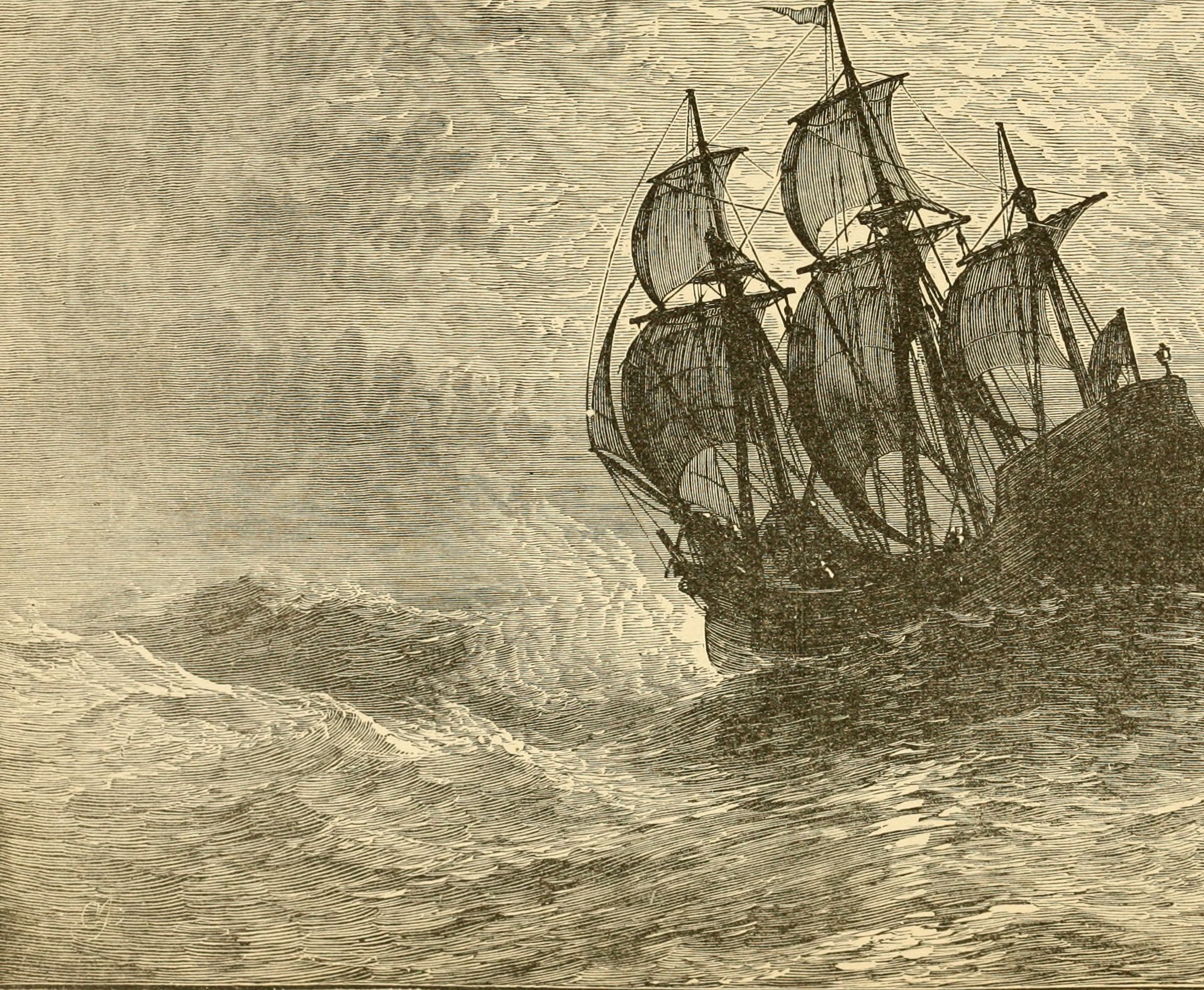
#9 Voyage of the Mayflower
In 1620, the Mayflower set sail from Plymouth, England, carrying a group of English Puritans seeking religious freedom. These passengers, now known as Pilgrims, endured a harsh 66-day journey across the Atlantic. Overcrowded conditions and winter storms made for a brutal trip, but on November 9th, they finally spotted land – Cape Cod – on the coast of present-day Massachusetts. This wasn’t their intended destination, but after exploring further south and facing harsh weather, they decided to settle in Plymouth, establishing the first permanent European colony in New England.
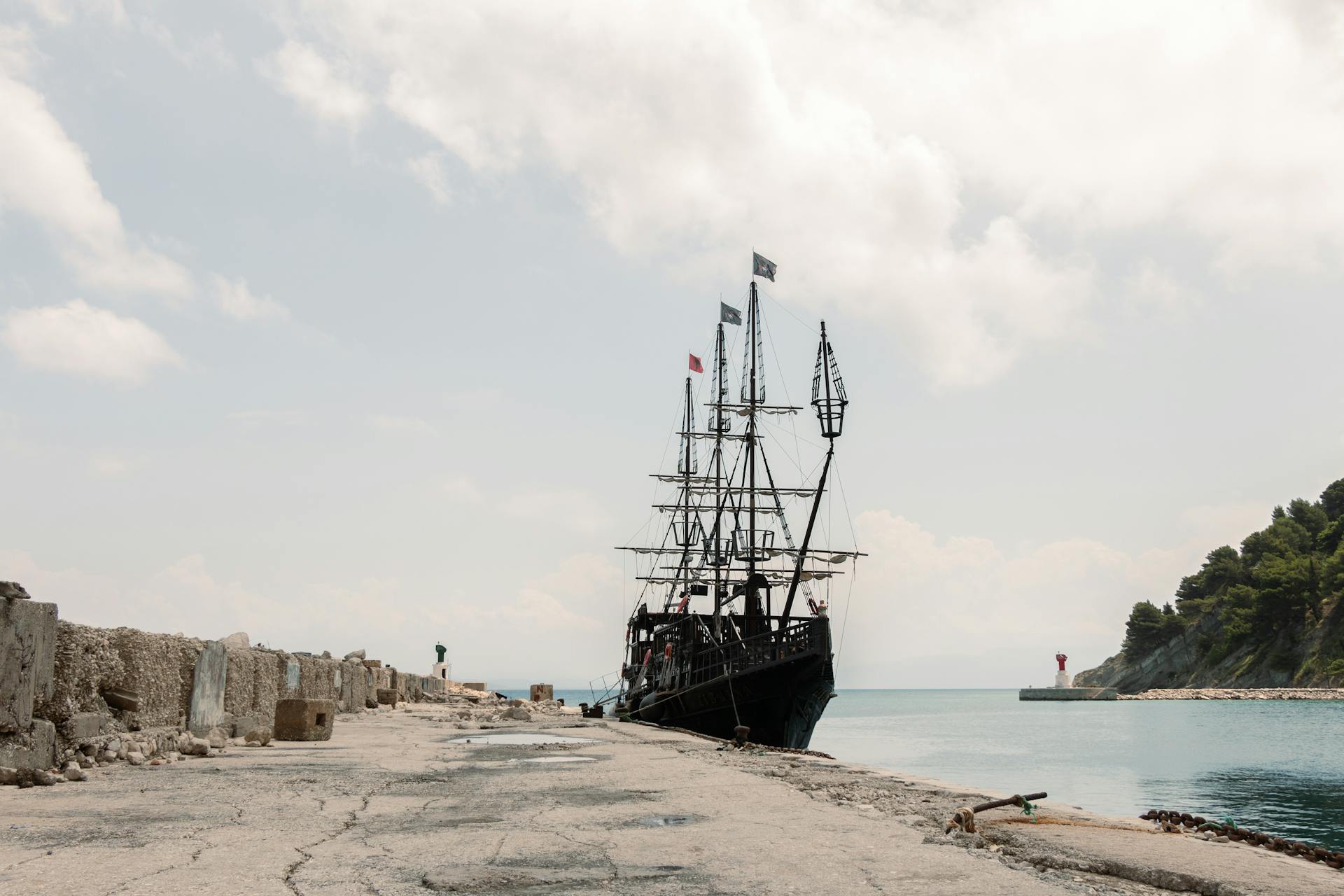
#10 Willem Janszoon’s Voyage to Australia
Willem Janszoon captained the Duyfken on the first documented European voyage to Australia in 1606. Sailing from Indonesia, Janszoon charted the western coast of Cape York Peninsula. Though meeting resistance from Aboriginal Australians, his exploration paved the way for further European ventures. This opened the door to future colonization and forever changed Australia’s history.
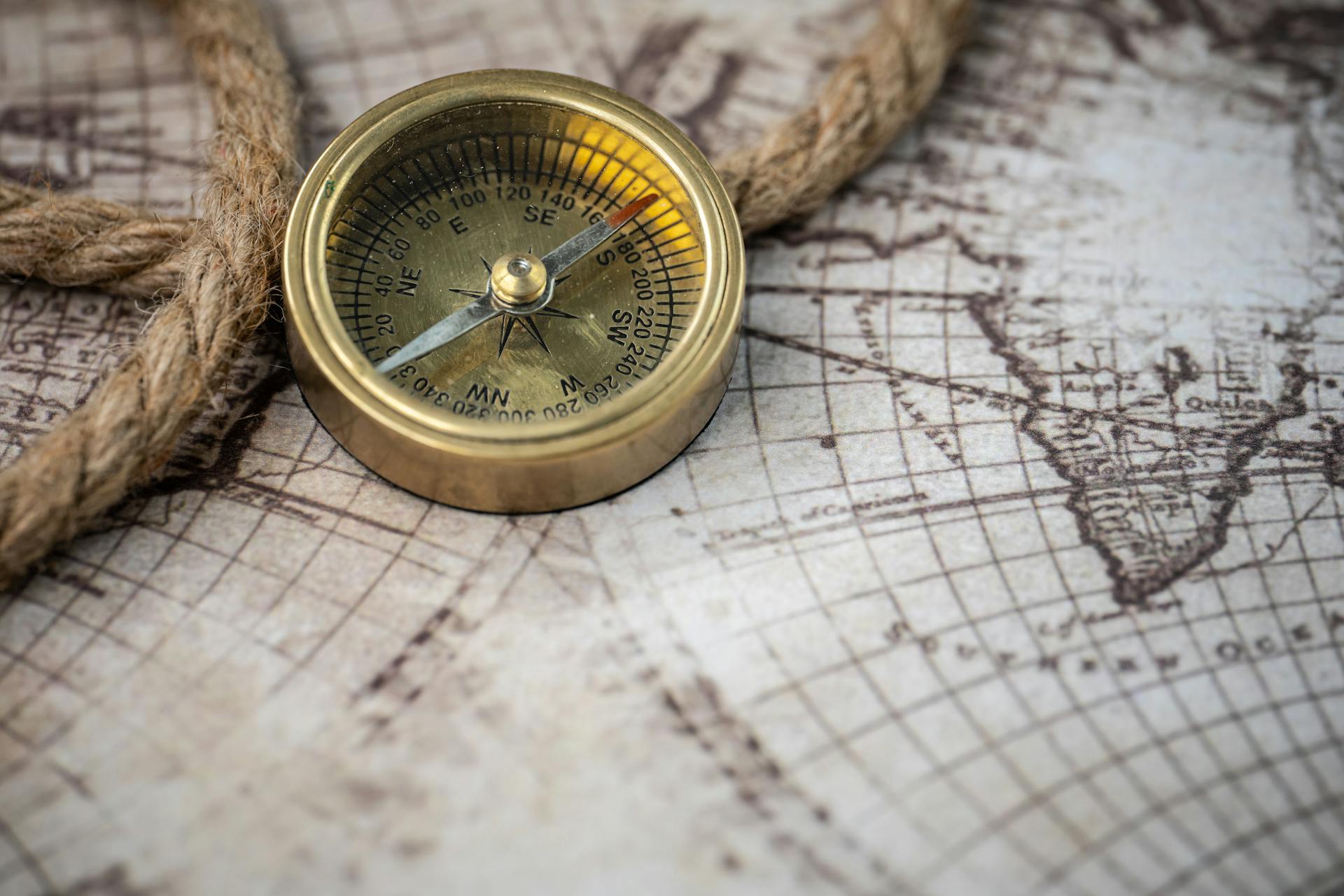
#11 Abel Tasman’s Voyages (1642-1644)
In the 1600s, Dutch East India Company explorer Abel Tasman ventured into the vast unknown of the Southern Hemisphere. His voyages charted large stretches of the Australian and New Zealand coastlines, revealing these lands to Europe for the first time. Despite facing challenges like rough weather and encounters with indigenous people, Tasman’s expeditions paved the way for further Dutch exploration and settlement in the region.
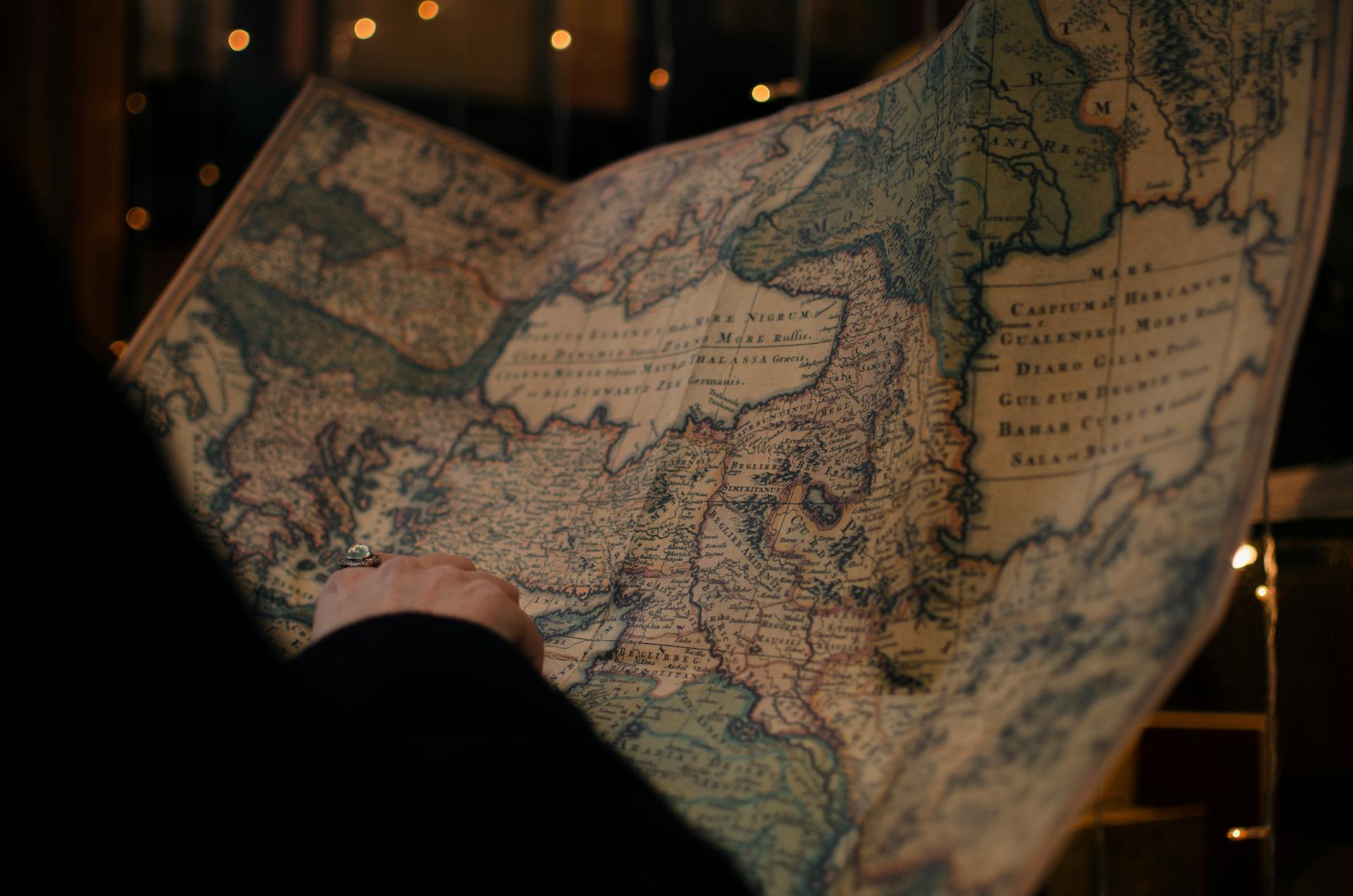
#12 John Cabot’s Exploration of North America
John Cabot’s 1497 voyage was a pioneering European exploration of North America funded by England. After setting sail from Bristol, Cabot likely landed somewhere between Newfoundland and Labrador. Though the specifics are debated, Cabot’s expedition secured England’s claims in North America and opened the door for future exploration and colonization. This voyage ultimately helped pave the way for permanent English settlements and the Thirteen Colonies.

#13 Marco Polo’s Travels to China
In 1271, Marco Polo, a young Venetian, embarked on a remarkable journey with his father and uncle. Their travels spanned over two decades, taking them along the Silk Road to the heart of Kublai Khan’s Mongol Empire in China. Marco, known for his keen observations, spent 17 years serving the emperor, gaining firsthand experience of the Mongol and Chinese culture, technology (like paper money!), and wonders like the Grand Canal. His eventual return to Venice, filled with tales of a faraway land, inspired Europeans and ignited their fascination with the East.

#14 Jacques Cartier’s Exploration of Canada
Funded by King Francis I, Jacques Cartier’s early 1500s voyages explored the Gulf of St. Lawrence and Canada’s coastline. He mapped the St. Lawrence River and laid the groundwork for French claims in the region. Though facing harsh weather and tensions with Indigenous people, Cartier’s expeditions opened the door for a lasting French presence in Canada.
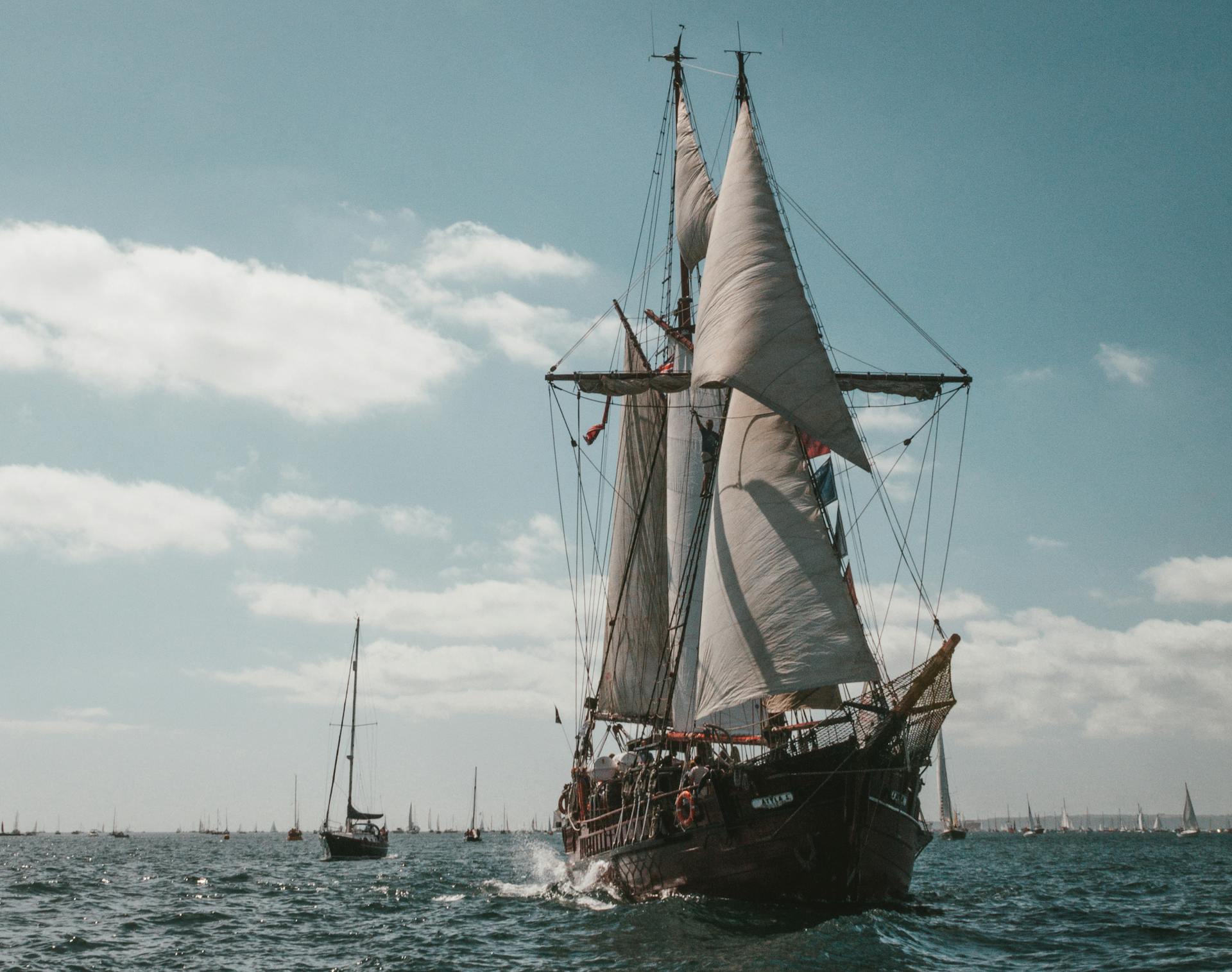
#15 Pedro Álvares Cabral’s Voyage to Brazil
In 1500, Pedro Álvares Cabral, heading for India, accidentally landed in Brazil due to navigation mistakes. This unplanned stop sparked Portuguese exploration and turned Brazil into a resource treasure trove rich with timber, sugar, and gold. Cabral’s voyage paved the way for Portuguese colonization of South America, making Brazil a dominant colonial power.
Like our content? Be sure to follow us .

11 Biggest Mistakes That Grandparents Make
Grandparents play an important role in a family, offering love, support, and a unique connection for their grandchildren. However, even the most well-intentioned grandparent can make missteps that unintentionally create tension or undermine the parents’ authority. Here are 11 common mistakes grandparents can avoid to foster stronger, healthier relationships with their families.

20 Bucket List Experiences to Check Off After You Retire
Retirement is a time for pursuing lifelong dreams and exploring new adventures. Creating a bucket list can help guide you in making the most of this stage by checking off meaningful experiences and trying new things. Whether you’re looking for thrilling activities, cultural immersion, or opportunities for reflection, there is something for everyone on this list of 20 inspiring bucket list experiences.
More for You
20 facts you might not know about 'John Wick'
I was fired from a new job in less than a week after I started. It taught me not every opportunity is a good opportunity.
19 Things People Treat As Safe That Actually Are Pretty Dangerous
29 common human foods you may not realize are poisonous to your dog
Bethenny Frankel, fiancé Paul Bernon reportedly split after nearly six years together
Your senses will shut down in a specific order when you’re about to die
Ranking the 21 'American Idol' winners
Employers Are Avoiding Hiring Gen Z Workers- Here's Why
College softball rankings: 2024 NCAA Top 25 poll
Russian Plane Intercepted Near NATO Country
What Is the Most Poisonous Spider in the World?
Doctor shares what happens to our bodies moments before we die
18 Things That Will Happen if 70 Becomes the New Retirement Age in the US
Blox Fruits Codes (May 2024): Free Money, Stat Resets, XP Boosts & More
There are two realities in the 2024 election. They almost collided today.
Apple Unveils AI Enhanced iPhone 16 with Advanced Features
George Clooney, Regina King, Michael Keaton and More Call on Hollywood to Make 'Films With Purpose' After Participant Closure
Top 10 Most Expensive Cars in the World
15 Shocking Reasons Why More Baby Boomers Are Getting Divorced
Fashion news! Sydney Sweeney swaps trousers for heels, Mercedes gets chic and Armani's London exhibition

IMAGES
VIDEO
COMMENTS
Between 1492 and 1504, the Italian navigator and explorer Christopher Columbus led four transatlantic maritime expeditions in the name of the Catholic Monarchs of Spain to the Caribbean and to Central and South America. These voyages led to the widespread knowledge of the New World.This breakthrough inaugurated the period known as the Age of Discovery, which saw the colonization of the ...
The explorer Christopher Columbus made four voyages across the Atlantic Ocean from Spain: in 1492, 1493, 1498 and 1502. His most famous was his first voyage, commanding the ships the Nina, the ...
Christopher Columbus - Explorer, Voyages, New World: The ships for the first voyage—the Niña, Pinta, and Santa María—were fitted out at Palos, on the Tinto River in Spain. Consortia put together by a royal treasury official and composed mainly of Genoese and Florentine bankers in Sevilla (Seville) provided at least 1,140,000 maravedis to outfit the expedition, and Columbus supplied more ...
Christopher Columbus. Christopher Columbus (born between August 26 and October 31?, 1451, Genoa [Italy]—died May 20, 1506, Valladolid, Spain) was a master navigator and admiral whose four transatlantic voyages (1492-93, 1493-96, 1498-1500, and 1502-04) opened the way for European exploration, exploitation, and colonization of the ...
How was the first voyage of Columbus to the New World undertaken, and what was its legacy? Having convinced the King and Queen of Spain to finance his voyage, Christopher Columbus departed mainland Spain on August 3, 1492. He quickly made port in the Canary Islands for a final restocking and left there on September 6.
Caravels of Columbus. Columbus set sail from Spain in three ships: the Nina, the Pinta, and the Santa Maria. On August 3, 1492, Italian explorer Christopher Columbus started his voyage across the Atlantic Ocean. With a crew of 90 men and three ships—the Niña, Pinta, and Santa Maria—he left from Palos de la Frontera, Spain.
Christopher Columbus was an Italian explorer and navigator. In 1492, he sailed across the Atlantic Ocean from Spain in the Santa Maria, with the Pinta and the Niña ships alongside, hoping to find ...
Columbus' voyage departed in August of 1492 with 87 men sailing on three ships: the Niña, the Pinta, and the Santa María. Columbus commanded the Santa María, while the Niña was led by Vicente Yanez Pinzon and the Pinta by Martin Pinzon. 3 This was the first of his four trips. He headed west from Spain across the Atlantic Ocean.
First Voyage: 1492-1493 CE; Second Voyage: 1493-1496 CE; Third Voyage: 1498-1500 CE; Fourth Voyage: 1502-1504 CE; Columbus never set out to discover a New World, but to find a western sea route to the Far East to facilitate trade after the land route of the Silk Road, between Europe and the East, had been closed by the Ottoman Empire in 1453 CE, initiating the so-called Age of Exploration ...
The Book of Privileges is a collection of agreements between Columbus and the crowns of Spain prepared in Seville in 1502 before his 4th and final voyage to America. The compilation of documents includes the 1497 confirmation of the rights to titles and profits granted to the Admiral by the 1492 Contract of Santa Fé and augmented in 1493 and 1494, as well as routine instructions and ...
In 1492 he obtained the sponsorship of the Spanish monarchs Ferdinand II and Isabella I for an attempt to reach Asia by sailing westward over what was presumed to be open sea. On his first voyage he set sail in August 1492 with three ships—the Santa María, the Niña, and the Pinta—and land was sighted in the Bahamas on October 12. He ...
Christopher Columbus (/ k ə ˈ l ʌ m b ə s /; between 25 August and 31 October 1451 - 20 May 1506) was an Italian explorer and navigator from the Republic of Genoa who completed four Spanish-based voyages across the Atlantic Ocean sponsored by the Catholic Monarchs, opening the way for the widespread European exploration and European colonization of the Americas.
How did his voyages change the course of world history? British Broadcasting Corporation Home. ... and on 3 August 1492, Columbus and his fleet of three ships, the Santa Maria, the Pinta and the ...
Columbus reports on his first voyage, 1493. A Spotlight on a Primary Source by Christopher Columbus. On August 3, 1492, Columbus set sail from Spain to find an all-water route to Asia. On October 12, more than two months later, Columbus landed on an island in the Bahamas that he called San Salvador; the natives called it Guanahani.
However, after the Spanish conquest of the Moorish kingdom of Granada in January 1492, the Spanish monarchs, flush with victory, agreed to support his voyage. On August 3, 1492, Columbus set sail ...
This engraving depicts Columbus's first landing in the New World, on the island he called San Salvador, on October 12, 1492. Columbus is surrounded by his men on the beach. Discussing the landing in his journal, Columbus wrote that he "leaped on shore, and . . . took, possession of the said island for the King and for the Queen." [1]
When Christopher Columbus arrived on the Bahamian Island of Guanahani (San Salvador) in 1492, he encountered the Taíno people, whom he described in letters as "naked as the day they were born." The Taíno had complex hierarchical religious, political, and social systems. Skilled farmers and navigators, they wrote music and poetry and created ...
Christopher Columbus - Exploration, Caribbean, Americas: The gold, parrots, spices, and human captives Columbus displayed for his sovereigns at Barcelona convinced all of the need for a rapid second voyage. Columbus was now at the height of his popularity, and he led at least 17 ships out from Cádiz on September 25, 1493. Colonization and Christian evangelization were openly included this ...
20th,1492. Dr. Don Fernando Belmonte, an officer employed in the archives of Seville, recently discovered a document which refers to the expulsion of the Jews from Palos while Columbus was equipping his expedition. I t is a process taken before the Corregidor of Moguer in January 1552, and one Juan de Arag'ln, a native of Moguer, then
Second Voyage Adds Colonization and Trading Posts to Exploration Goals. Christopher Columbus returned from his first voyage in March 1493, having discovered the New World—although he didn't know it. He still believed that he had found some uncharted islands near Japan or China and that further exploration was needed.
The exhibition examines the first sustained contacts between American people and European explorers, conquerors and settlers from 1492 to 1600. During this period, in the wake of Columbus's voyages, Africans also arrived in the hemisphere, usually as slaves. All of these encounters, some brutal and traumatic, others more gradual, irreversibly ...
A timeline of major events in the life of Italian-born navigator and explorer Christopher Columbus, whose four transatlantic voyages (1492-93, 1493-96, 1498-1500, and 1502-04) opened the way for European exploration, exploitation, and colonization of the Americas.
In 1492, Christopher Columbus embarked on his famous first voyage. With backing from the Spanish crown, he set sail from Spain with three ships - the Niña, the Pinta, and the Santa Maria.
In April 1492 Columbus was awarded the title "Admiral of the Ocean Sea," and Spain agreed to finance his first expedition. First Voyage (1492-93) ... Columbus embarked on his final voyage on May 9, 1502. Although plagued by illness, Columbus insisted on leading the expedition, believing his voyages were divinely inspired. ...